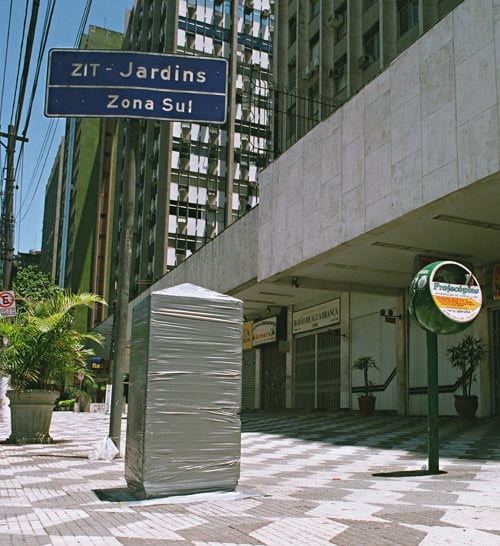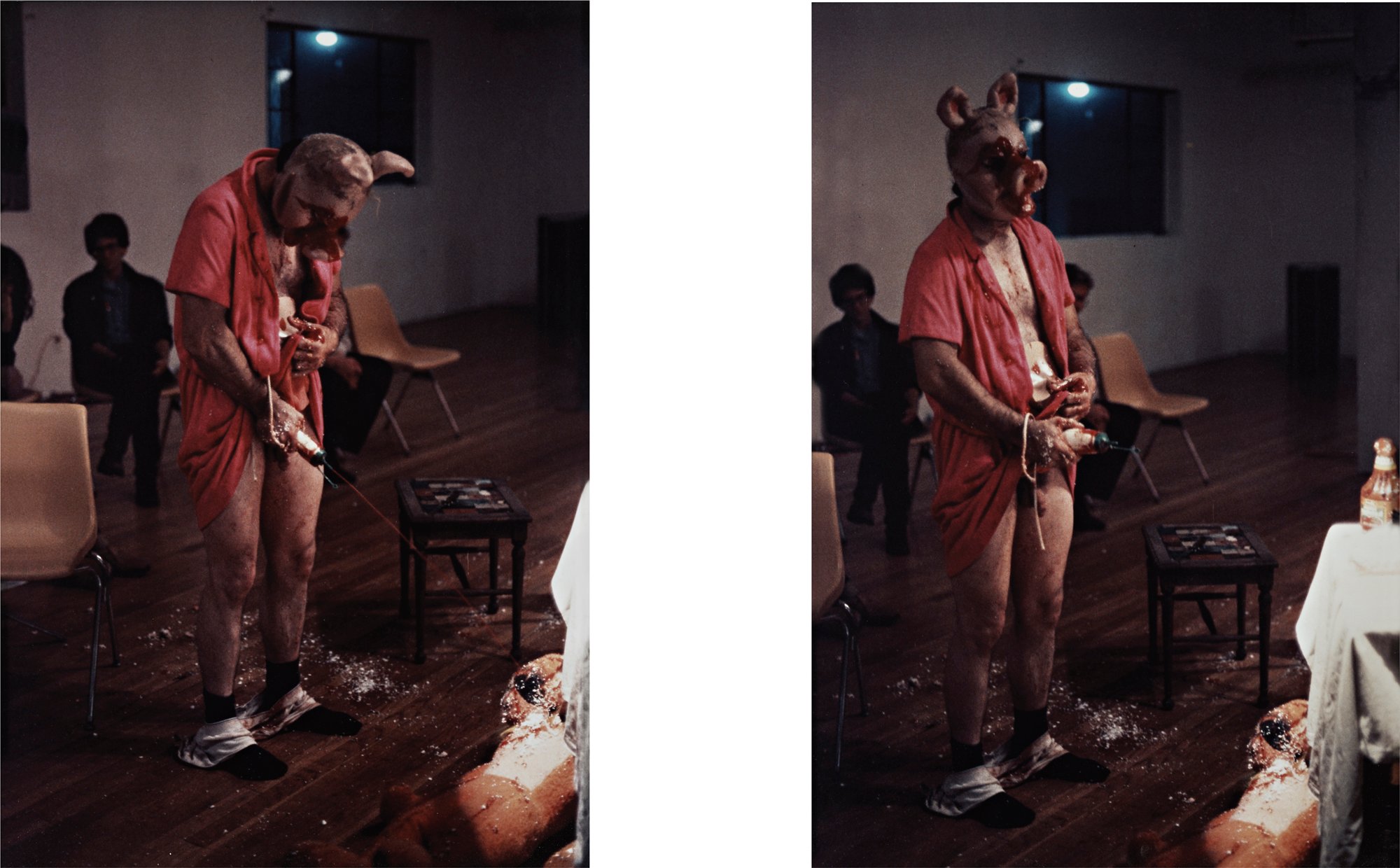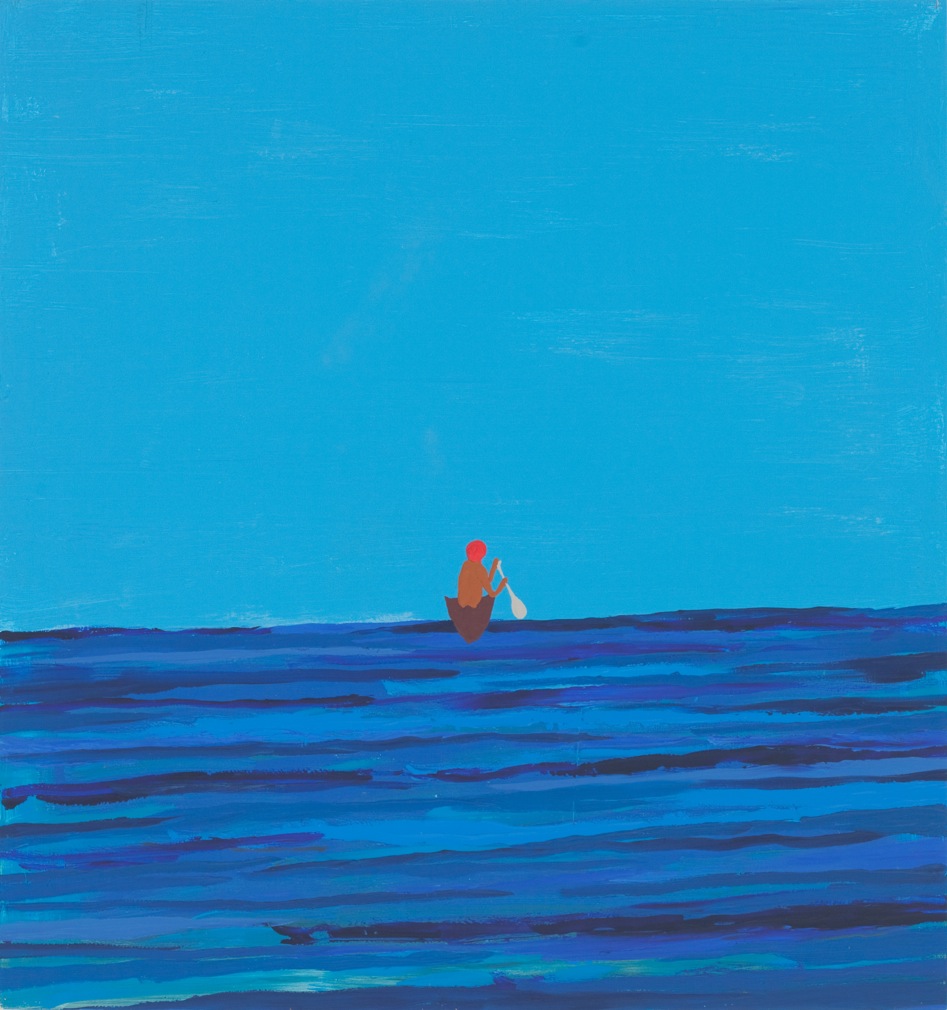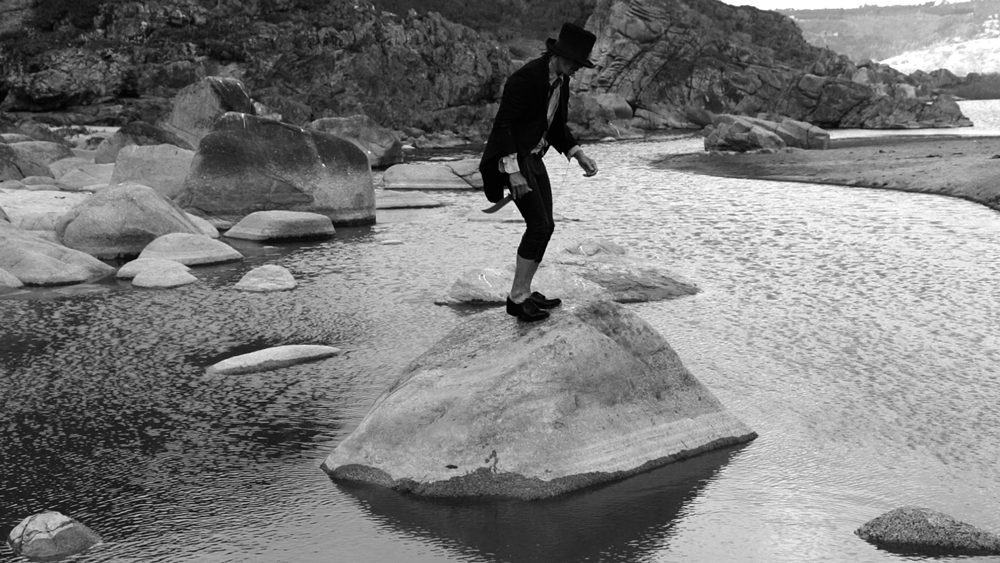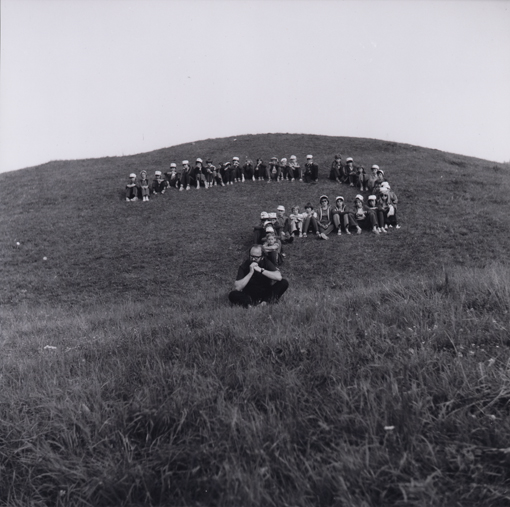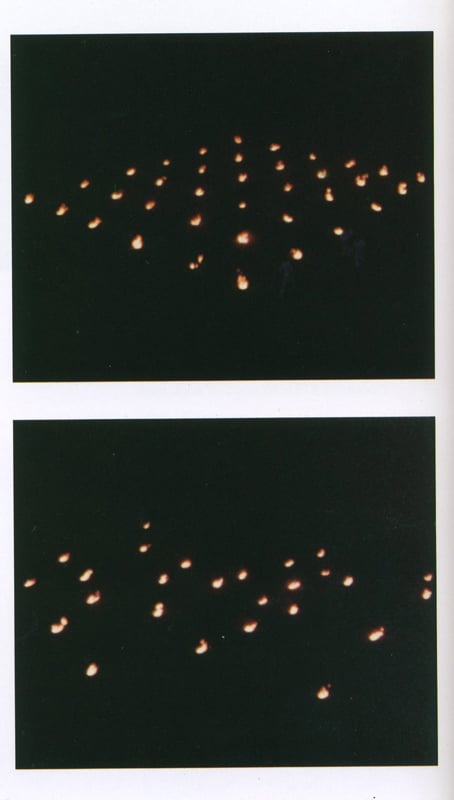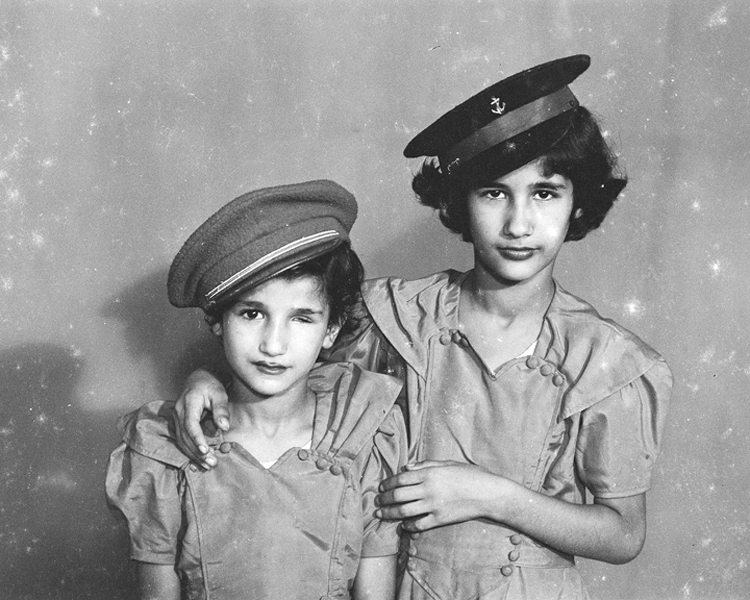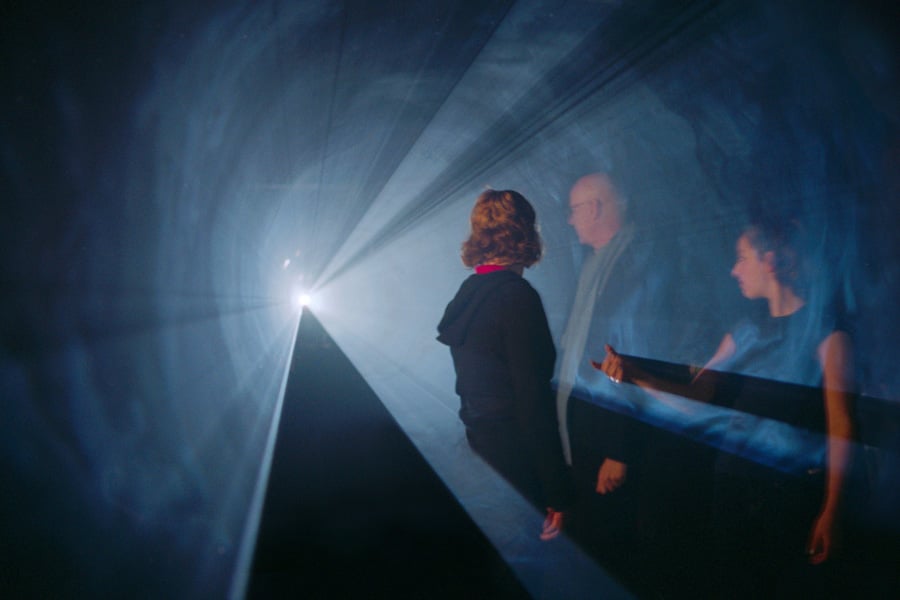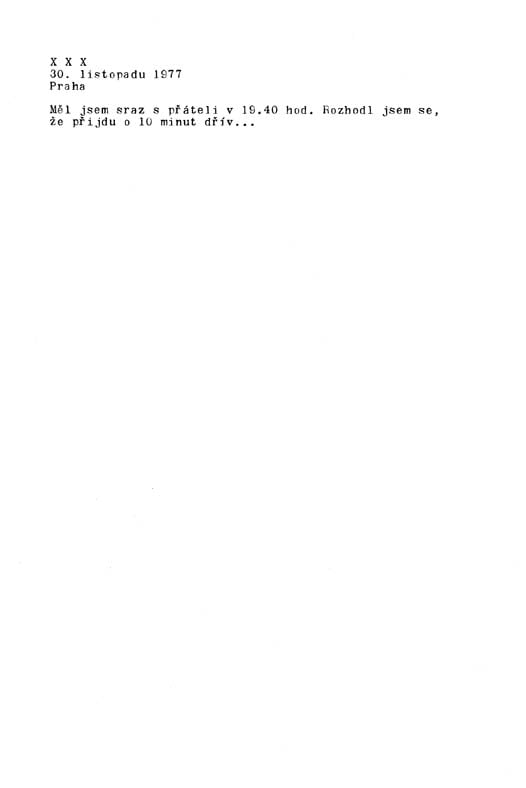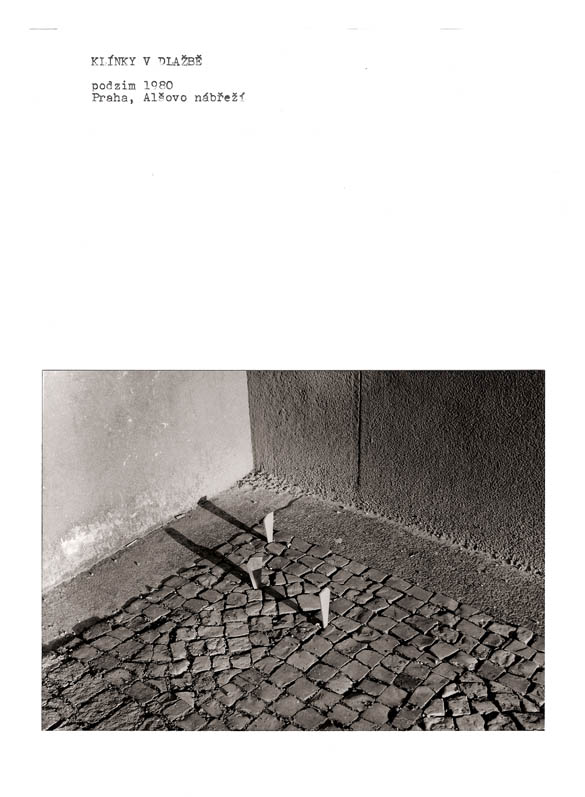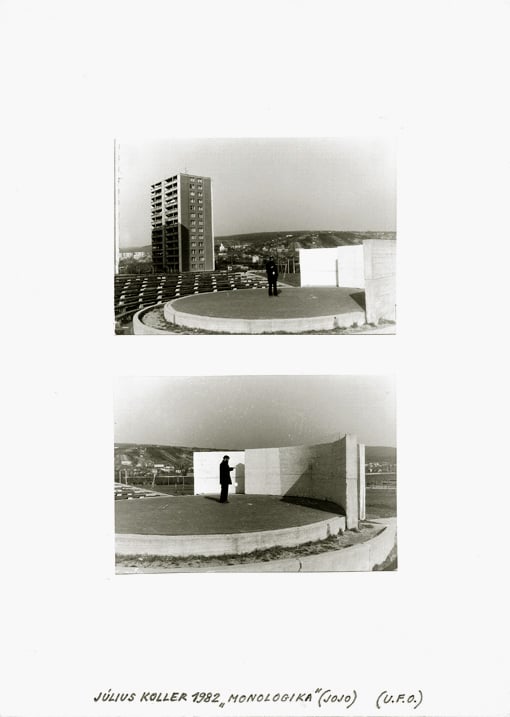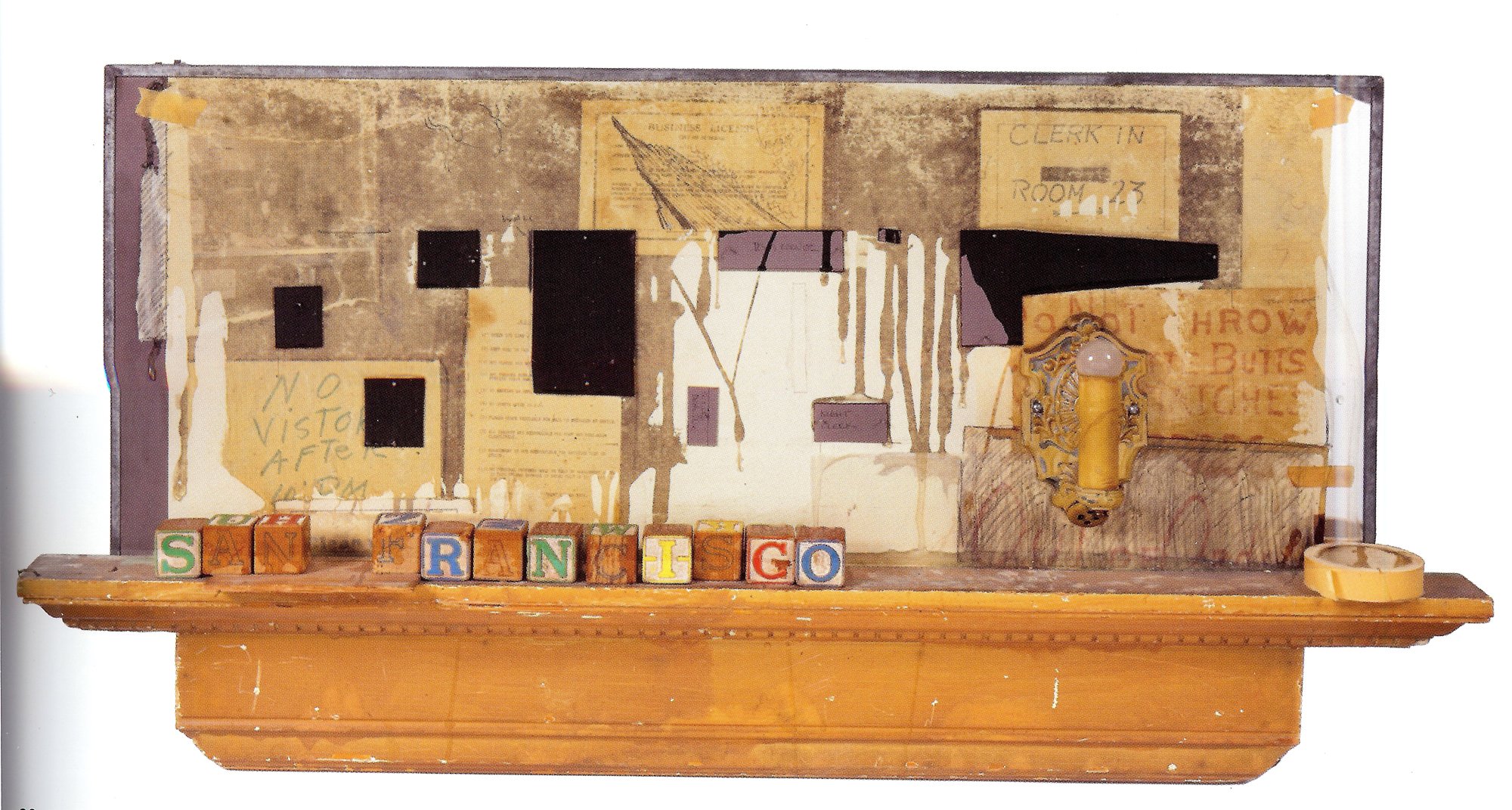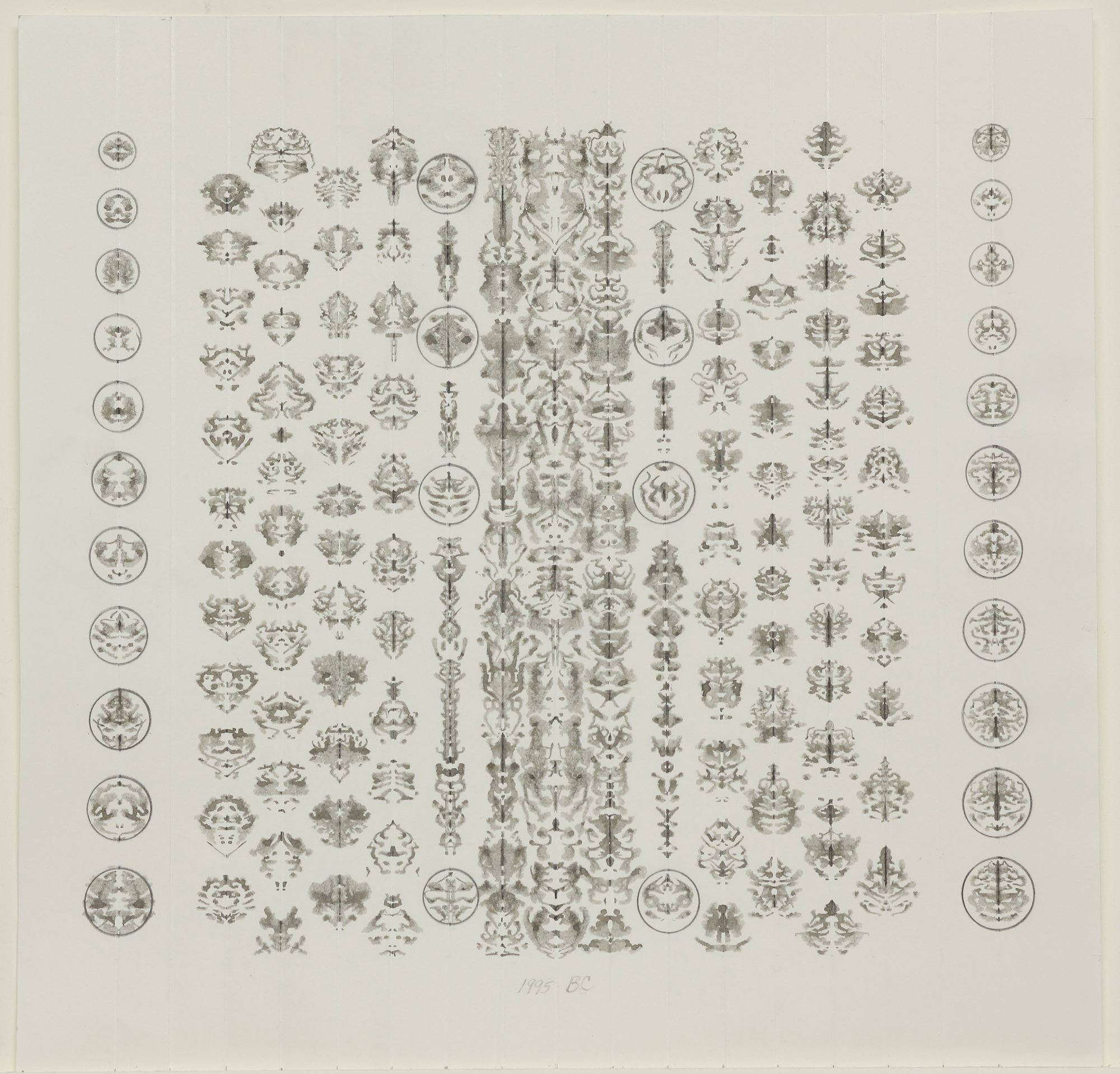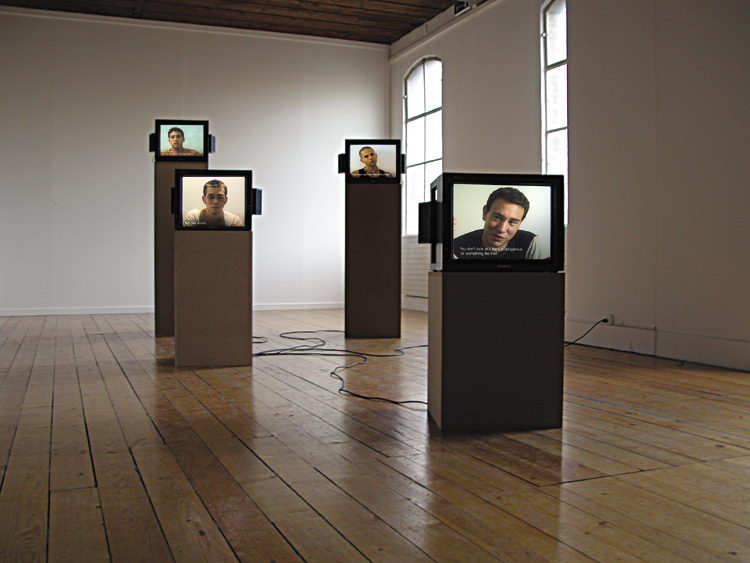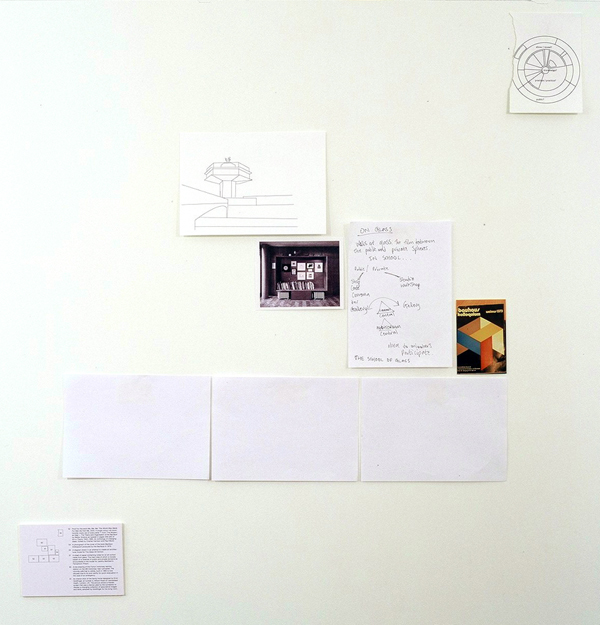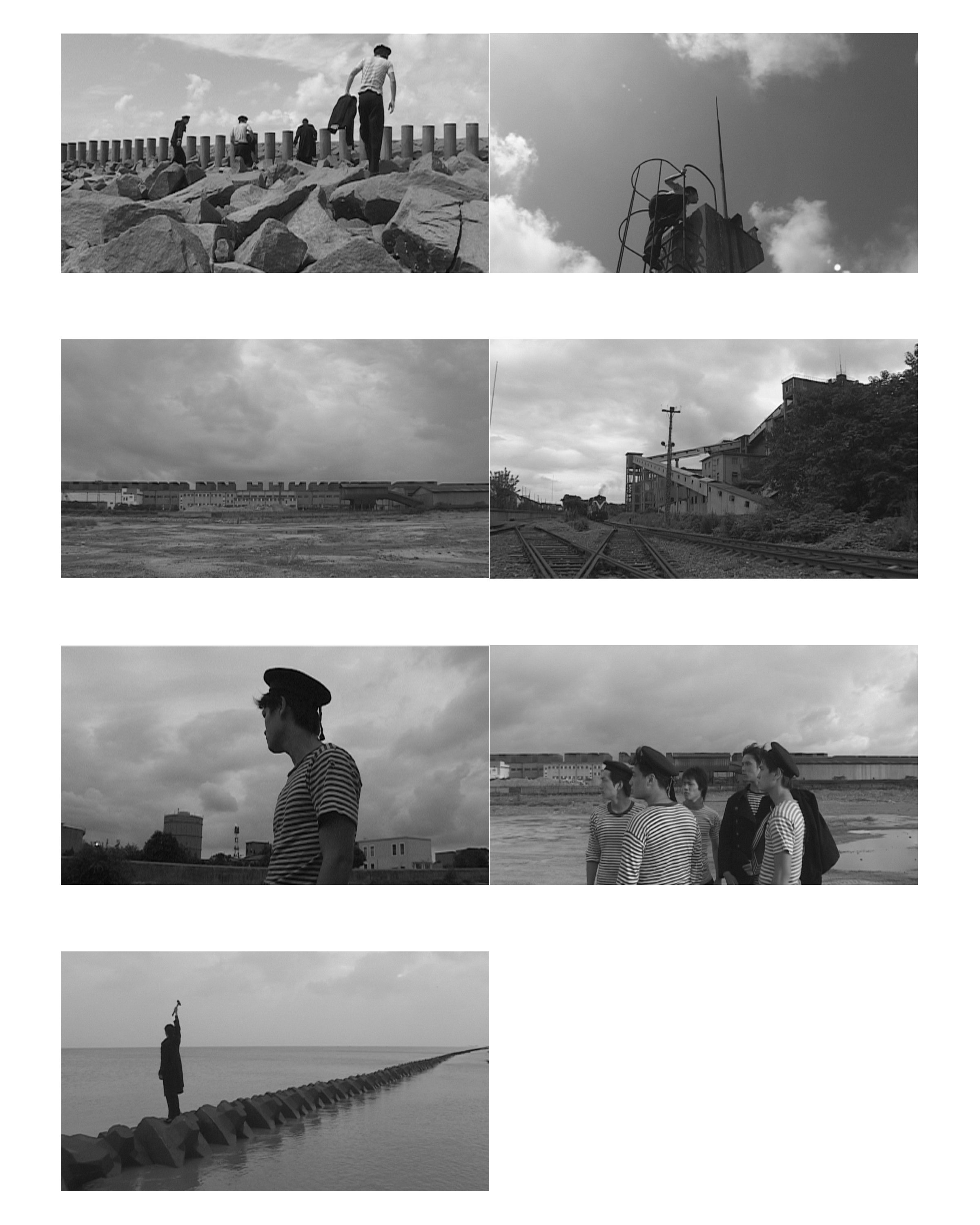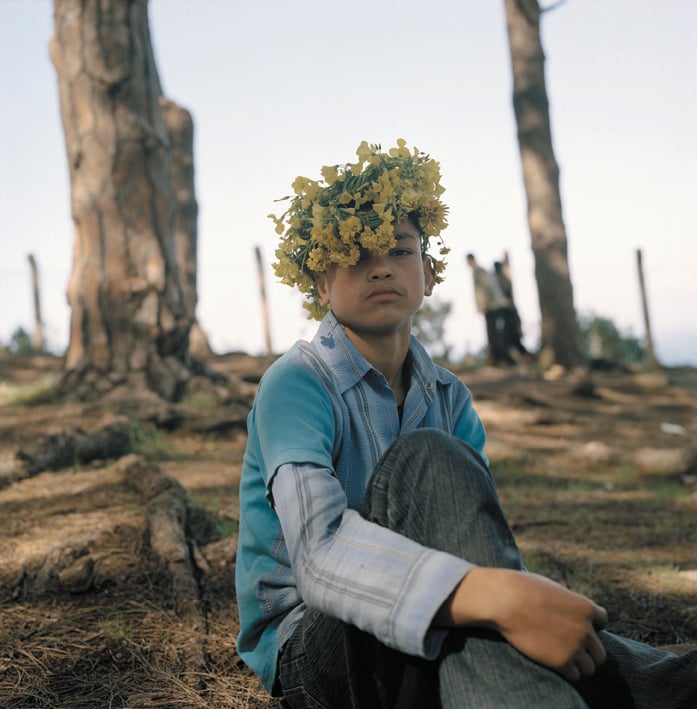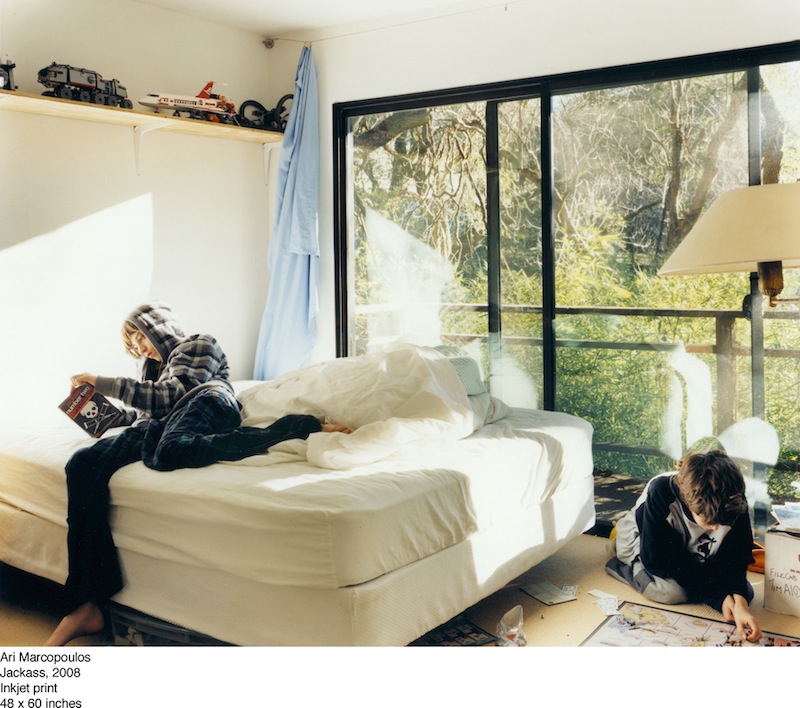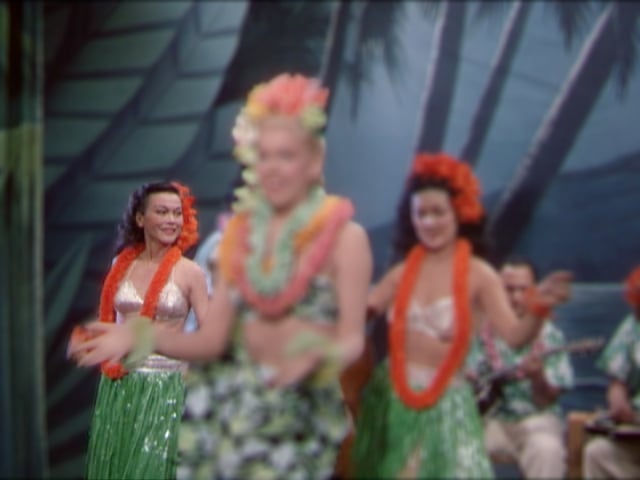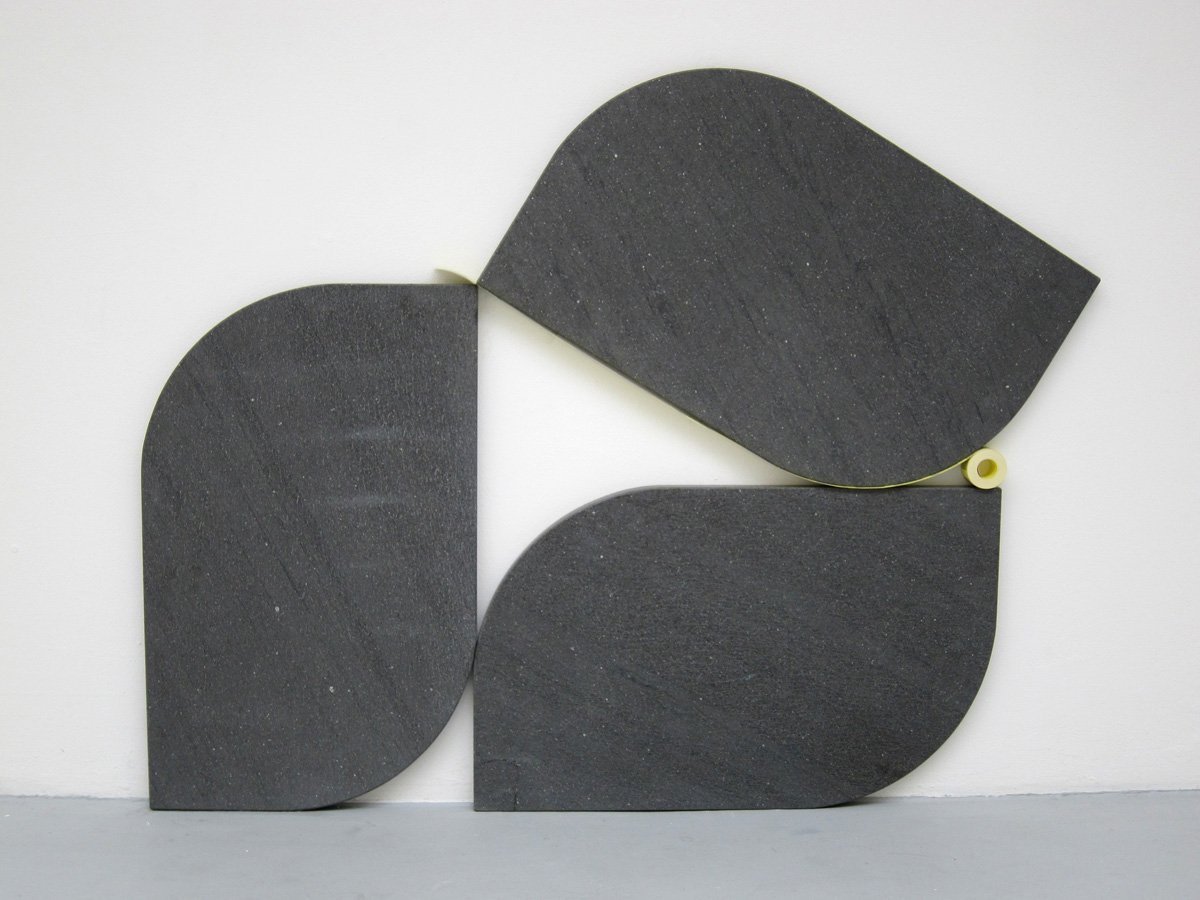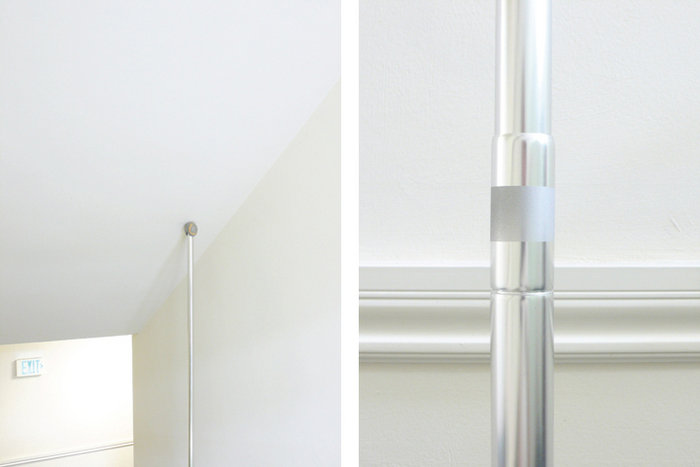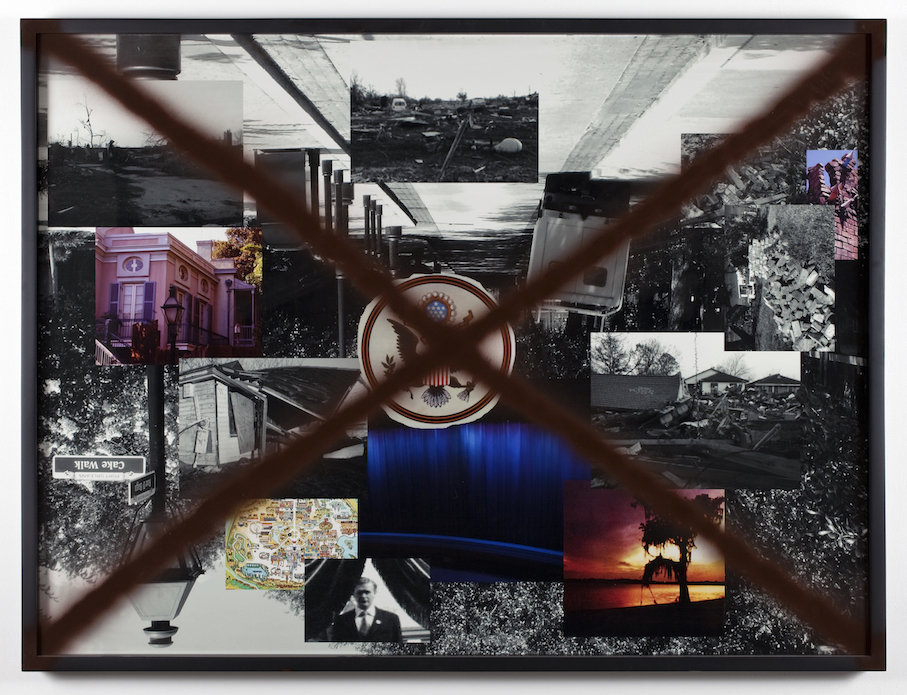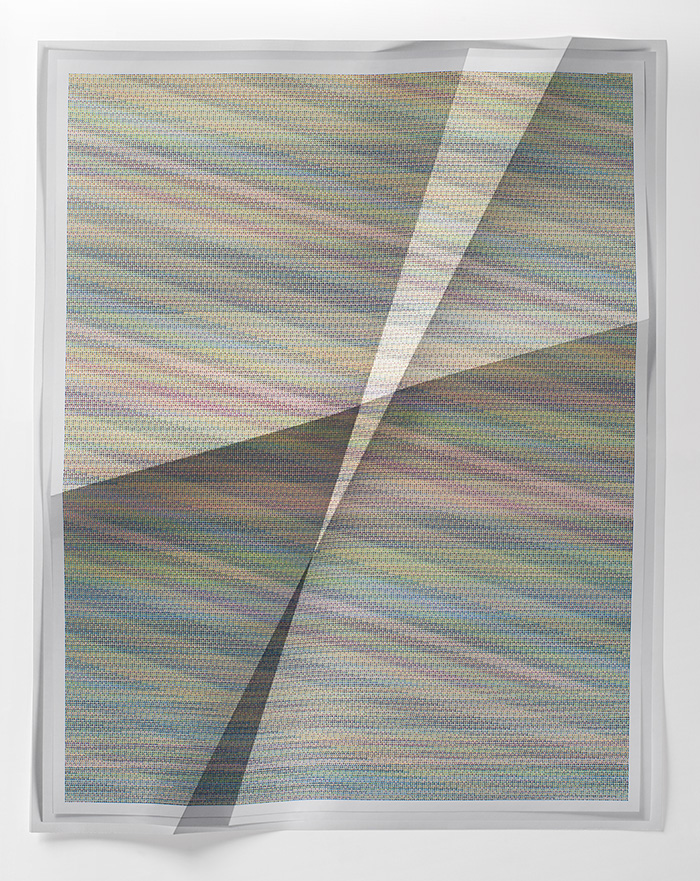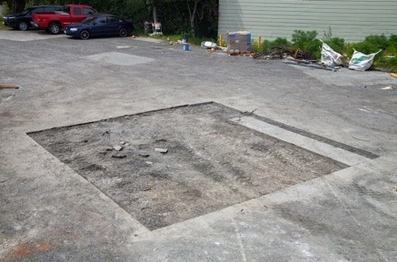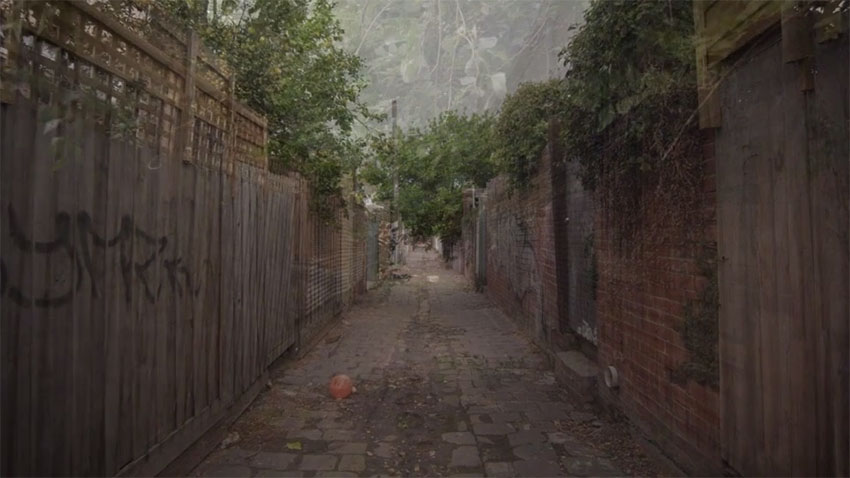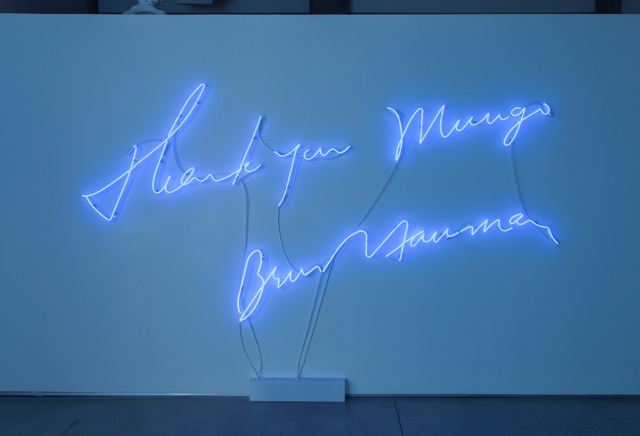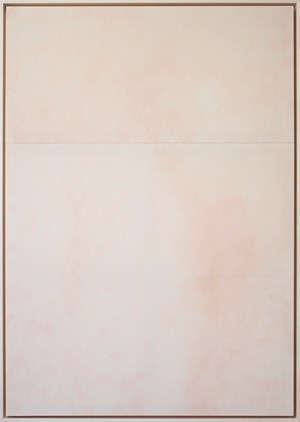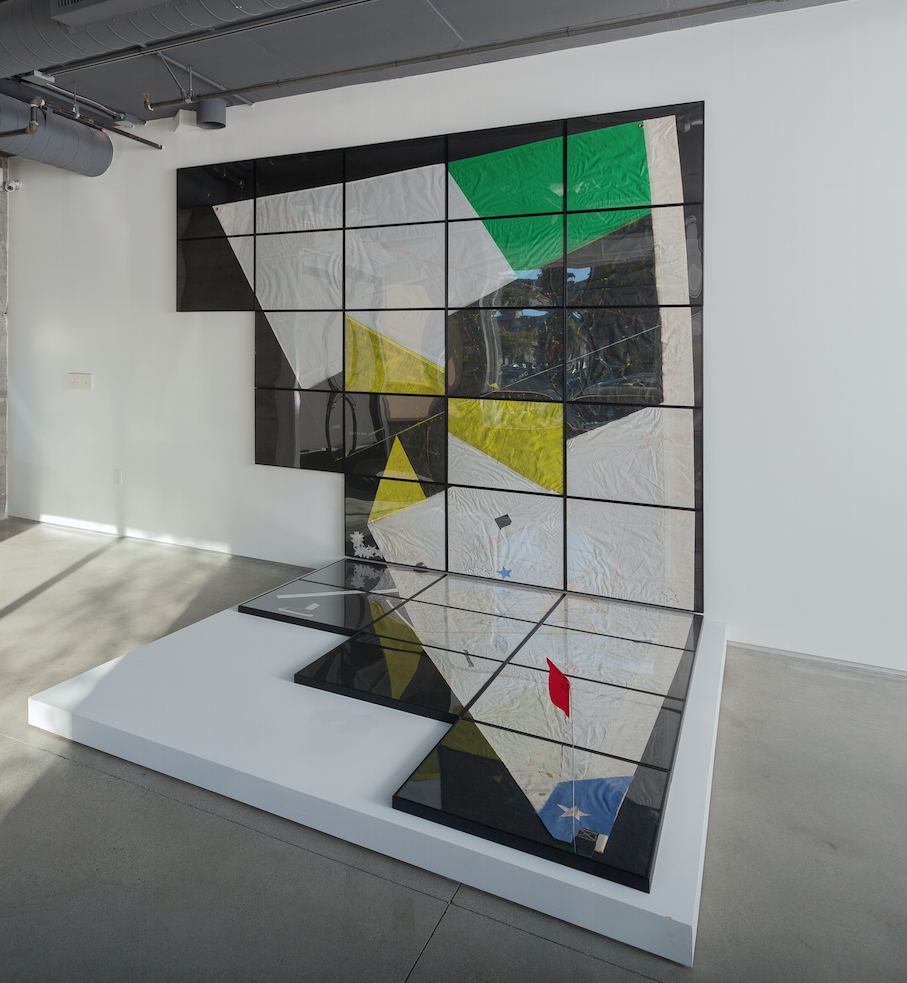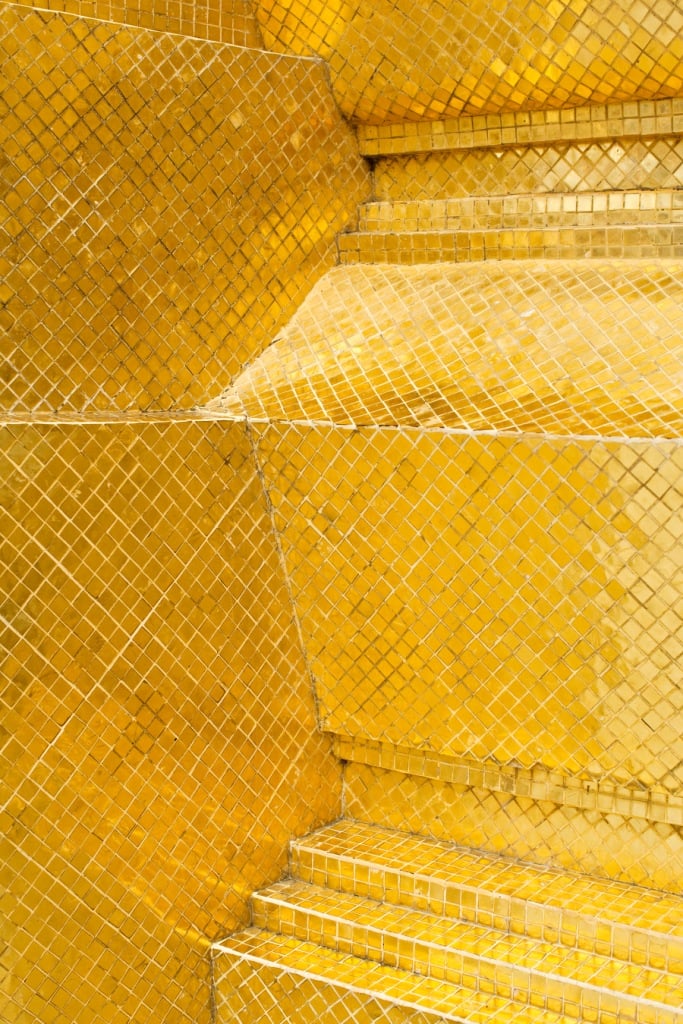
© » KADIST
Chris Wiley
Architectural details become abstracted renderings in Chris Wiley’s inkjet prints 11 and 20 (both 2012). In photographing seemingly mundane images of doorways and walls, Wiley collapses the viewer’s experience of inhabiting space by foregrounding features that we all too often miss in our built environment: the peeling white paint on a Corinthian column or the rusty studs on a blue door.

© » KADIST
Jiang Zhi
5 is a three channel video about the dualities of death and resurrection, reminiscence and fantasy, chronological and retrospective narration. The main video features two dancers intertwining, caressing in trancelike movements, with intimacy eventually leading to scarring and bleeding. Towards the end, the trace of bodily movements and fluids crescendo in an image of a skull in a synthesis of performance, painting and theater.

© » KADIST
Simon Starling
Invited in 2007 to the Museum Folkwang in Essen (Germany), Simon Starling questioned its history: known for its collections and particularly for its early engagement in favor of modern art (including the acquisition and exhibition of works by Cézanne, Gauguin, Van Gogh, Matisse), then destroyed during the Second World War, the museum was pillaged for its masterpieces of ‘degenerate art’ by the nazis. Starling found photographs of a hang dating back to 1929, taken by Albert Renger-Patzsch, the German New Objectivity photographer. Firstly, he researched the artworks that were presented then which for the most part had been restituted or acquired by private collectors after the war.

© » KADIST
Akram Zaatari
“People often asked if they could pose with the Kodak advertisement where a full scale woman is featured with a camera offering Kodak rolls. They invented the poses, the gestures and situations.” Hashem El Madani. Hashem El Madani, a studio photographer in Saida, began working in 1948.

© » KADIST
Martin Creed
This photograph of Martin Creed himself was used as the invitation card for a fundraising auction of works on paper at Christie’s South Kensington in support of Camden Arts Centre’s first year in a refurbished building in 2005. His broad smile, on the verge of laughter, encourages reciprocity on behalf of the onlooker. This could be said to be a typical tactic in Creed’s work as it is so infused with humor and irony.

© » KADIST
Julio Cesar Morales
Drawing & Print (Drawing & Print)
Julio Cesar Morales’s watercolor drawings, Undocumented Intervention , show a variety of surprising hiding places assumed by people trying to cross into the United States without documentation. Morales drew inspiration from both his childhood near the United States-Mexico border as well as from photographic documentation on U. S. government websites.

© » KADIST
Jedediah Caesar
For Untitled, Caesar encased recycled objects such as scraps of plywood, paper or cloth in resin and then cut and reassembled the pieces into abstract forms. This technical rework allows for a clinical inspection of the material contents of the piece and the resulting slanted industrial monolith echoes minimalist sculpture, although with a different expressive texture. Indeed, Untitled can be seen as a contemporary pyramid with a painterly surface.
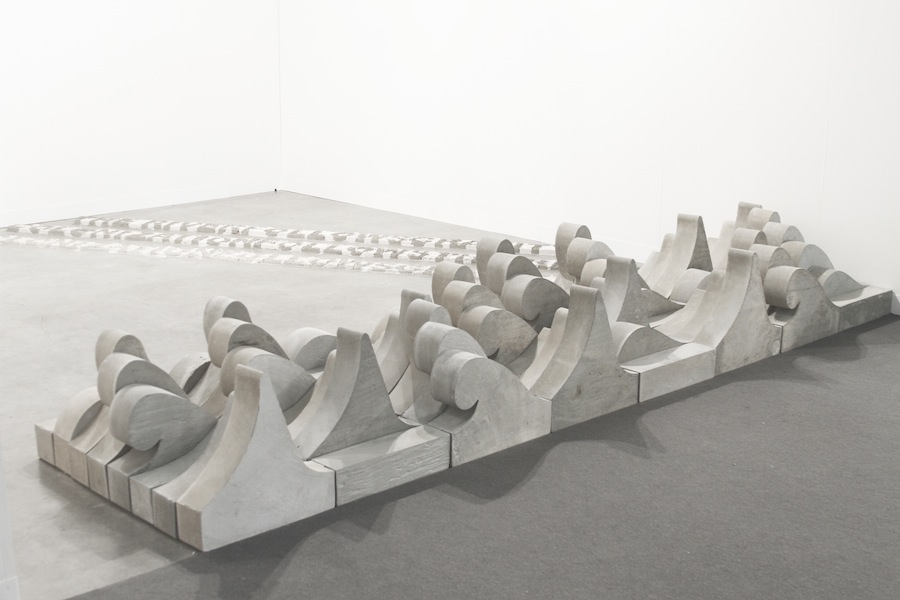
© » KADIST
Felipe Arturo
Primero estaba el mar ( First Was the Sea , 2012) is a system of equivalences between syllables and silhouettes of waveforms cast in cement. Each waveform represents a syllable of the sentence “Primero estaba el mar.” This sentence is the first verse of the Kogui poem of creation. For the Koguis, an indigenous community from the Sierra Nevada de Santa Marta on the Colombian Caribbean coast, water was the absolute presence before the creation of the universe.

© » KADIST
Will Rogan
Drawing & Print (Drawing & Print)
MUM , the acronym used to title a series of Rogan’s small interventions on found magazines, stands for “Magic Unity Might,” the name of a vintage trade magic publication. In the series, Rogan alters the magazine’s pages by erasing the image of the magicians doing their tricks, leaving only the background of their performances on view. These contexts range from the more overtly staged scenario in Silencer #16 —the erased magician is about to perform a trick on his assistant trapped on an odd, almost dada looking box—to the more “colloquial” Silencer #17 in which the absent magician’s silhouette appears in what seems to be a children’s hospital.
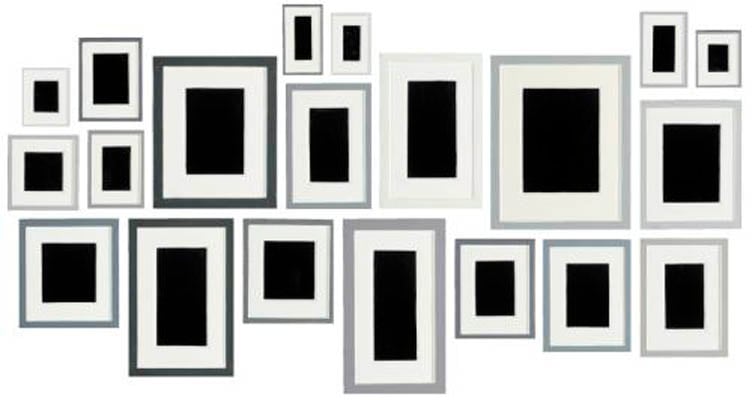
© » KADIST
Allan McCollum
In the work titled The Glossies (1980), an affinity for photography manifested itself before McCollum actually began to use photography as a medium. The Glossies are drawings, rectangular forms applied with blank ink and watercolors, which fill up the sheets parallel to the edges except for a small margin. Finally, the whole paper is covered with an adhesive plastic laminate, which gives it the shiny surface of a photograph.

© » KADIST
Sun Xun
Sun Xun’s lushly illustrated, dynamic short film Mythological Time is a dreamy chronicle of rapacious industrial development, the mythical qualities of state propaganda, and the constancy of change, as experienced by an unnamed coal mining town. While it is not named in the film itself, the town at the center of Mythological Time is a re-imagined incarnation of Sun’s hometown of Fuxin, in the northern Chinese province of Liaoning. Sandwiched between North Korea and Inner Mongolia, Fuxin is a poor coal-mining region that used to contain one of China’s largest open-pit mines and has historically been the site of significant conflict, thanks to its rich mineral resources.
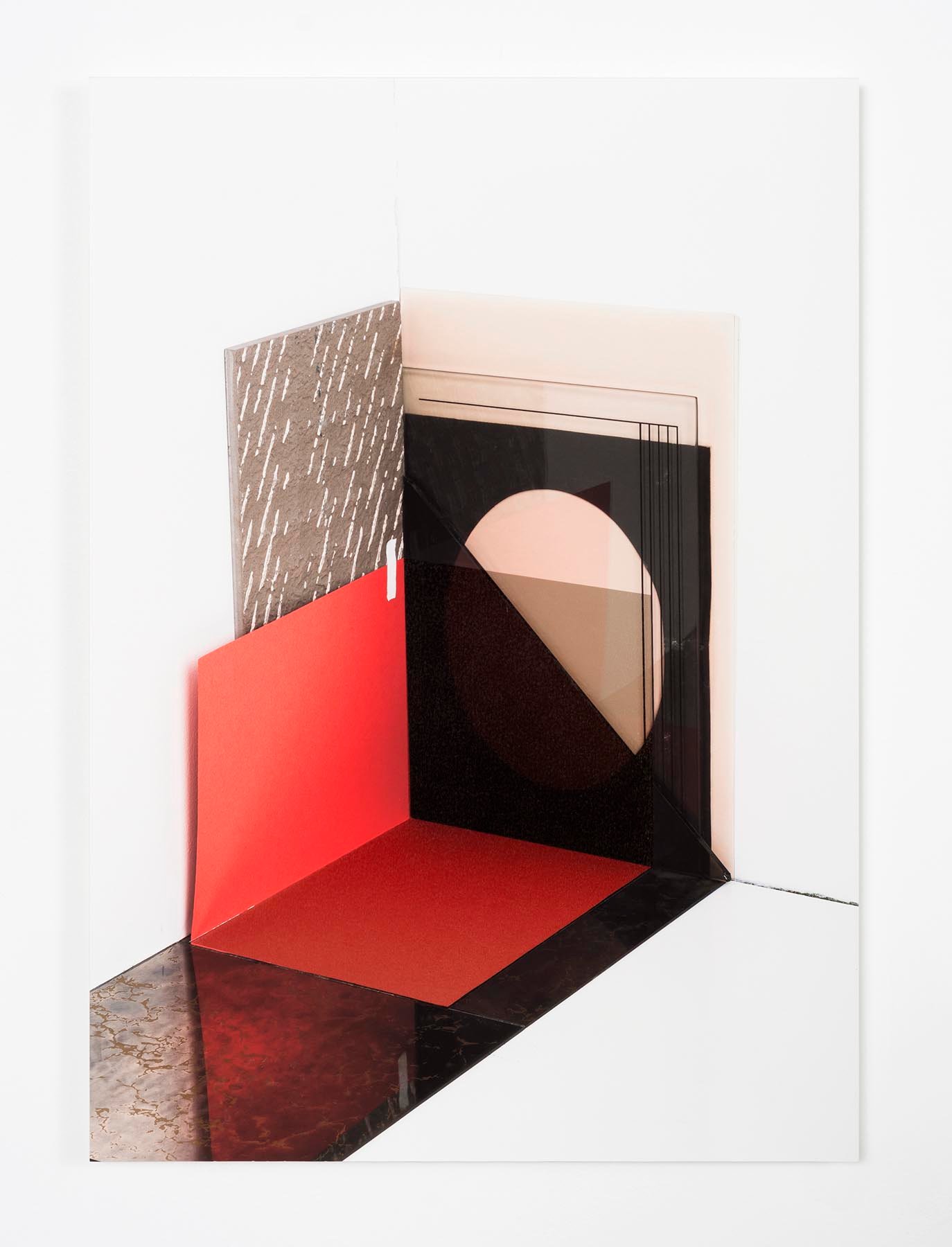
© » KADIST
Phillip Maisel
While his works can function as abstract, they are very much rooted in physicality and the possibilities that are inherent in the materials themselves. Elements used in various stages of photographic processes (color filters, glassine, and prints themselves) are integrated back into the artwork either as part of the sculpture or as collage elements that are later added to the print. In some of the works, Maisel cuts into the prints themselves.

© » KADIST
Keith Tyson
The work of Keith Tyson is concerned with an interest in generative systems, and embraces the complexity and interconnectedness of existence. Philosophical problems such as the nature of causality, the roles of probability and design in human experience, and the limits and possibilities of human knowledge, animate much of his work. Language as a coded system, as a representation medium, but also as something that generates a whole variety of realities also plays a central role.
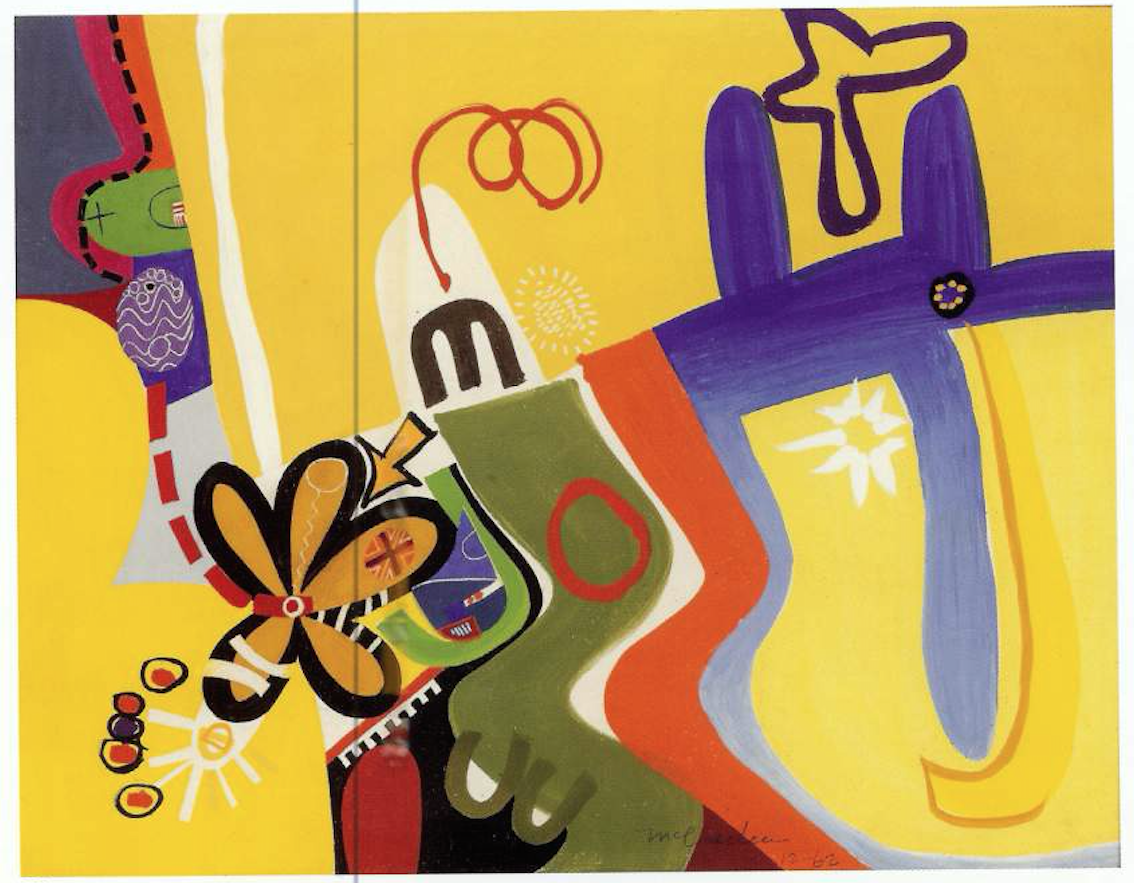
© » KADIST
John McCracken
Though not strictly representational, some objects in Untitled (1962) are recognizable: a flower, an egg, a foot. The arrows and directional lines suggest movement, but the forms they point to intertwine, prohibiting a straightforward reading. The shapes are as illustrative as a Rorschach inkblot; in their confounding, simple indeterminacy, they depict nothing and everything at once.

© » KADIST
Will Rogan
Will Rogan’s video Eraser (2014) shows a hearse parked in a clearing amidst leaf barren trees. The steely grey sky stands in stark contrast to the vehicle’s luminously pristine white finish and makes this already deathly object seem even more ghostly. The grass underneath is half-turned brown and further marks this as a lifeless landscape.

© » KADIST
Douglas Gordon
Douglas Gordon’s single-channel video The Left Hand Can’t See That The Right Hand is Blind, captures an unfolding scene between two hands in leather gloves—at first seemingly comfortable to be entwined, and later, engaged in a struggle. As suggested by the work’s title, each of the hands assumes a character with a distinct personality, as if we were witnessing a lovers’ quarrel and embrace, or the embodiment of opposing forces of an internal struggle. Gordon has previously created performance-based works depicting his own body or parts of it—arms, hands, fingers, eyes—usually enacting simple, repetitive movements.
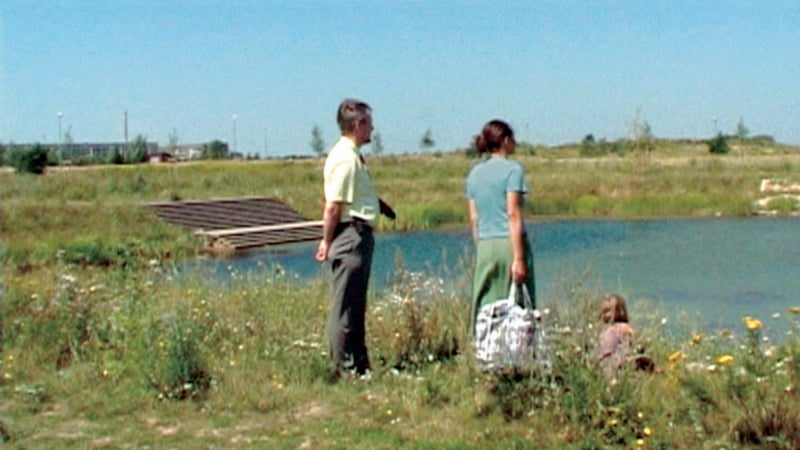
© » KADIST
Clemens von Wedemeyer
Die Siedlung is a filmic documentary about the recent shift in housing developments in Leipzig-Grünau in former East Germany and its consequences on some inhabitants. It complements von Wedemeyer slightly earlier and more artistic film Silberhöhe (2003) which decried imposed Modernist living model. In Die Siedlung , a voiceover describes and criticizes the different sites on view while the camera moves slowly past a vast abandoned 1930s Nazi army barracks which has yet to be converted or demolished, the building site and wastelands for the new private single family housing area, a constructed pond and finally the 1960s or 70s communal blocks of flats.

© » KADIST
Juan Araujo
Residencia Milan 1 is a painting of a house surrounded by lush forest. The image depicted is both photorealistic and creates the illusion of an unfolded piece of paper, with creases and discolorations. In referring to the circulation of images, the painting raises questions of a viewer’s relationship to the image of a beautiful house: as icon, wish, or standard of beauty.

© » KADIST
Gregory Crewdson
Forest Gathering N.2 is part of the series of photographs Beneath the Roses (2003-2005) where anonymous townscapes, forest clearings and broad, desolate streets are revealed as sites of mystery and wonder; similarly, ostensibly banal interiors become the staging grounds for strange human scenarios. These scenes are tangibly atmospheric, visually alluring and often deeply disquieting. Never anchored precisely in time or place, these and the other narratives of Beneath the Roses are rather located in the dystopic landscape of the anxious American imagination.

© » KADIST
Cildo Meireles
Meireles, whose work often involves sound, refers to Sal Sem Carne (Salt Without Meat) as a “sound sculpture.” The printed images and sounds recorded on this vinyl record and it’s lithographed sleeve describe the massacre of the Krahó people of Brazil. The piece draws on Meireles’s first-hand contact with many indigenous groups through his father’s work with the Indian Protection Service. The recordings on the LP contain narrative accounts of massacres of native peoples, as well as indigenous music and rituals.

© » KADIST
Raymond Pettibon
The five works included in the Kadist Collection are representative of Pettibon’s complex drawings which are much more narrative than comics or cartoon. The images allude to recurring topics, such as the superhero (present both in Untitled Superman and No title without the comics ), a book cover (his literary sources), or a mushroom cloud. Inspired by the writings of William Faulkner, Daniel Defoe, Gustave Flaubert, Marcel Proust, and James Joyce, Pettibon’s sophisticated, witty drawings combine image and text to explore the gamut of American popular culture.
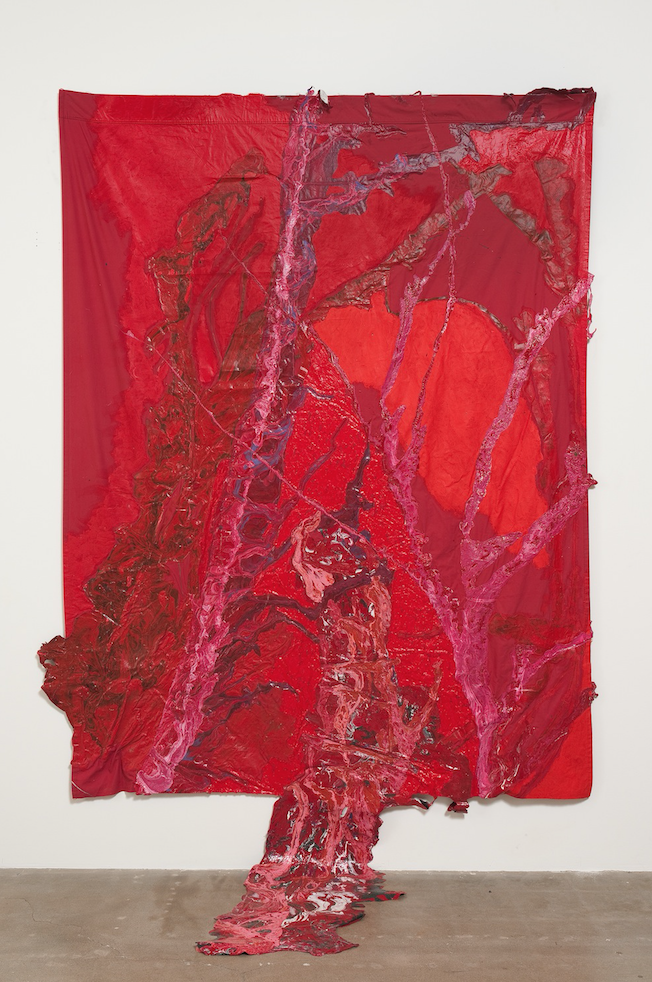
© » KADIST
Rodney McMillian
In his evocative Landscape Paintings, McMillian uses second-hand bedsheets, sourced from thrift shops, as his starting point. Calling up the unknown intimacies of these objects, McMillian upends their usual orientation, placing them directly on the wall to serve as paintings, rather than covers. Layering over the repurposed textiles with hardware store paint, McMillian transforms the sheets into canvases, creating abstract landscapes on top of the traces of human bodies intact in the fabric.

© » KADIST
Igor Grubic
366 Liberation Rituals is a series that gathers a number of actions related to the artist’s micro-politics. They materialize as a plurality of pointers that destabilize reality and interrogate our outlook on the political historicity of former Yugoslavia. These actions were realized over the course of the year the artist turned forty and revolved for one part around the revolutionary movement of 1968 and on the other on the informal group called Grupa šestorice autora (Group of Six Authors)* which was active in Zagreb between 1975 and 1979.

© » KADIST
Matt Lipps
In the series Horizons (2010), Lipps uses appropriation to riff on Modernism’s fascination with abstract form. For Untitled (Men) (2011), he snipped from magazines and textbooks pictures of handsome or famous men, from the ancient Greek to the modern. Arranged in a tableau, lit theatrically, and rephotographed, the two-dimensional figures have an embodied presence.

© » KADIST
Jiang Pengyi
Unregistered City is a series of eight photographs depicting different scenes of a vacant, apparently post-apocalyptic city: Some are covered by dust and others are submerged by water. Yet, ambiguous lights blink from buildings and yachts still sail on the water, and further observation reveals these structures to be miniatures manipulated by the artist through Photoshop and other postproduction image tools. The model city’s surroundings are themselves real abandoned spaces, perhaps an empty room, a wait-to-be demolished building, or a discarded bathtub.
Akram Zaatari
- location: Sayda, Al-Lubnan
- year born: 1966
- gender: male
- nationality: Lebanese
Mario Garcia Torres
- location: Mexico City, Mexico
- year born: 1975
- gender: male
- nationality: Mexican
- home town: Monclova, Mexico
Alexandre da Cunha
- location: London, United Kingdom
- year born: 1969
- gender: male
- nationality: Brazilian
- home town: Rio de Janeiro, Brazil
Mungo Thomson
- location: Los Angeles, California
- year born: 1969
- gender: male
- nationality: American
Raymond Pettibon
- location: Hermosa Beach, California
- year born: 1957
- gender: male
- nationality: American
- home town: Tucson, Arizona
Xiaoyun Chen
- location: Hangzhou, China
- year born: 1971
- gender: male
- nationality: Chinese
- home town: Hubei Province, China
Paul McCarthy
- location: Los Angeles, California
- year born: 1945
- gender: male
- nationality: American
- home town: Salt Lake City, Utah
Hank Willis Thomas
- location: New York, New York
- year born: 1976
- gender: male
- nationality: American
- home town: Plainfield, New Jersey
Chris Johanson
- location: Los Angeles, California
- year born: 1968
- gender: male
- nationality: American
- home town: San Jose, California
Carlos Amorales
- year born: 1970
- gender: male
- nationality: Mexican
- home town: Mexico City, Mexico
Joachim Koester
- year born: 1962
- gender: male
- nationality: Danish
- home town: Copenhagen, Denmark
Juan Araujo
- year born: 1971
- gender: male
- nationality: Spanish
- home town: Caracas, Venezuela
Julius Koller
- location: Pieštany, Slovenská Republika
- year born: 1939
- gender: male
- nationality: Slovakian
Juan Capistran
- location: Los Angeles, California
- gender: male
- nationality: Mexican American
- home town: Guadalajara, Mexico
Jiri Kovanda
- location: Praha, Ceská Republika
- year born: 1953
- gender: male
- nationality: Czech
Anthony McCall
- location: London, United Kingdom
- year born: 1946
- gender: male
- nationality: British
Clemens von Wedemeyer
- location: Göttingen, Deutschland
- year born: 1974
- gender: male
- nationality: German
Chen Chieh-Jen
- location: Taipei, Taiwan
- year born: 1960
- gender: male
- nationality: Chinese
- home town: Taoyuan, Taiwan
Sun Xun
- location: Hangzhou, China
- year born: 1980
- gender: male
- nationality: Chinese
- home town: Fuxin, Liaoning Provence, China
Chris Wiley
- location: New York, New York
- year born: 1981
- gender: male
- nationality: British
Jonathan Monk
- location: Berlin, Germany
- year born: 1969
- gender: male
- nationality: British
- home town: Leicester, United Kingdom
Zai Kuning
- year born: 1964
- gender: male
- nationality: Singaporean
- home town: Singapore
Kota Ezawa
- location: San Francisco, California
- year born: 1969
- gender: male
- nationality: German
- home town: Cologne, Germany
Omer Fast
- location: Yerushalayim, Yisra'el
- year born: 1972
- gender: male
- nationality: Israeli
Pak Sheung Chuen
- location: Hong Kong, China
- year born: 1977
- gender: male
- nationality: Chinese
- home town: Fujian, China
Pedro Reyes
- location: Mexico City, Mexico
- year born: 1972
- gender: male
- nationality: Mexican
- home town: Mexico City, Mexico
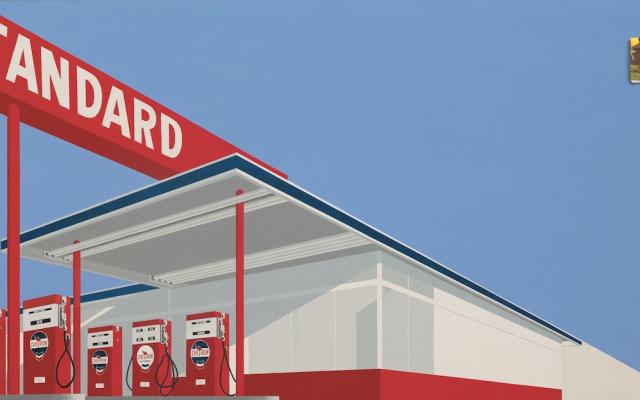
© » ART & OBJECT
about 4 months ago (12/12/2023)
Ed Ruscha's Poetry of the American Experience | Art & Object Skip to main content Subscribe to our free e-letter! Webform Your Email Address Role Art Collector/Enthusiast Artist Art World Professional Academic Country USA Afghanistan Albania Algeria American Samoa Andorra Angola Anguilla Antarctica Antigua & Barbuda Argentina Armenia Aruba Ascension Island Australia Austria Azerbaijan Bahamas Bahrain Bangladesh Barbados Belarus Belgium Belize Benin Bermuda Bhutan Bolivia Bosnia & Herzegovina Botswana Bouvet Island Brazil British Indian Ocean Territory British Virgin Islands Brunei Bulgaria Burkina Faso Burundi Cambodia Cameroon Canada Canary Islands Cape Verde Caribbean Netherlands Cayman Islands Central African Republic Ceuta & Melilla Chad Chile China Christmas Island Clipperton Island Cocos (Keeling) Islands Colombia Comoros Congo - Brazzaville Congo - Kinshasa Cook Islands Costa Rica Croatia Cuba Curaçao Cyprus Czechia Côte d’Ivoire Denmark Diego Garcia Djibouti Dominica Dominican Republic Ecuador Egypt El Salvador Equatorial Guinea Eritrea Estonia Eswatini Ethiopia Falkland Islands Faroe Islands Fiji Finland France French Guiana French Polynesia French Southern Territories Gabon Gambia Georgia Germany Ghana Gibraltar Greece Greenland Grenada Guadeloupe Guam Guatemala Guernsey Guinea Guinea-Bissau Guyana Haiti Heard & McDonald Islands Honduras Hong Kong SAR China Hungary Iceland India Indonesia Iran Iraq Ireland Isle of Man Israel Italy Jamaica Japan Jersey Jordan Kazakhstan Kenya Kiribati Kosovo Kuwait Kyrgyzstan Laos Latvia Lebanon Lesotho Liberia Libya Liechtenstein Lithuania Luxembourg Macao SAR China Madagascar Malawi Malaysia Maldives Mali Malta Marshall Islands Martinique Mauritania Mauritius Mayotte Mexico Micronesia Moldova Monaco Mongolia Montenegro Montserrat Morocco Mozambique Myanmar (Burma) Namibia Nauru Nepal Netherlands Netherlands Antilles New Caledonia New Zealand Nicaragua Niger Nigeria Niue Norfolk Island Northern Mariana Islands North Korea North Macedonia Norway Oman Outlying Oceania Pakistan Palau Palestinian Territories Panama Papua New Guinea Paraguay Peru Philippines Pitcairn Islands Poland Portugal Puerto Rico Qatar Romania Russia Rwanda Réunion Samoa San Marino Saudi Arabia Senegal Serbia Seychelles Sierra Leone Singapore Sint Maarten Slovakia Slovenia Solomon Islands Somalia South Africa South Georgia & South Sandwich Islands South Korea South Sudan Spain Sri Lanka St...
-
1940-1949
John Gutmann
1947Gutmann’s photographs Untitled Nob Hill and From the North Tower of the Golden Gate Bridge are some of the oldest pieces in the Kadist Collection and serve as historical anchors for many of the more recent works...
-
1950-1959
Akram Zaatari
1950“While taking the picture it was challenging to make the boys sit properly without moving...
Akram Zaatari
1956“People often asked if they could pose with the Kodak advertisement where a full scale woman is featured with a camera offering Kodak rolls...
-
1960-1969
Akram Zaatari
1960“When you position your hand on someone’s shoulder, your shoulders become straight and horizontal...
Akram Zaatari
1966“People often asked if they could pose with the Kodak advertisement where a full scale woman is featured with a camera offering Kodak rolls...
Wallace Berman
1969While Untitled (Shuffle) presents the same formal characteristics as the rest of Berman’s verifax collages, this constellation of specific images inside the radio’s frames—the Star of David, Hebrew characters, biblical animals—have Jewish symbolism and attest to the artist’s lasting obsession with the kabala...
-
1970-1979
Allen Ruppersberg
1970Untitled (City Limits) is a series of five black-and-white photographs of road signs, specifically the signs demarcating city limits of several small towns in California...
Akram Zaatari
1970“People often asked if they could pose with the Kodak advertisement where a full scale woman is featured with a camera offering Kodak rolls...
Anthony McCall
1973The film Line Describing a Cone was made in 1973 and it was projected for the first time at Fylkingen (Stockholm) on 30 August of the same year...
Cildo Meireles
1975Meireles, whose work often involves sound, refers to Sal Sem Carne (Salt Without Meat) as a “sound sculpture.” The printed images and sounds recorded on this vinyl record and it’s lithographed sleeve describe the massacre of the Krahó people of Brazil...
Jiri Kovanda
Drawing & Print
1977(Drawing & Print) All Kovanda’s artistic practice poses the question of visibility...
Jeffrey Vallance
1978Vallance’s Rocket is a vibrant picture in which masses of color and collage coalesce into a central vehicle, yet the whole surface seems lit with the roar of space travel...
-
1980-1989
Charles Gaines
1980To make his series Shadows (1980), Gaines subjected 20 potted plants to a uniform procedure...
Jiri Kovanda
1980Kovanda’s street interventions are always documented according to the same format as the actions: a piece of A4 paper, a typewritten text giving a precise location and date, and a photograph...
Allan McCollum
1982In the work titled The Glossies (1980), an affinity for photography manifested itself before McCollum actually began to use photography as a medium...
Paul McCarthy
1983McCarthy’s Mother Pig performance at Shushi Gallery in 1983 was the first time he used a set, a practice which came to characterize his later works...
Edward Kienholz
1984Untitled (San Francisco) was made in Idaho in 1984 and was facetiously dedicated to Henry Hopkins, the then director of the San Francisco Museum of Art who added “modern” to its name...
-
1990-1999
Rodney Graham
1991Ponderosa Pine IV belongs to a series of large-scale photographs of trees taken by Graham and depicts a particular species that live in Northern California...
Gabriel Orozco
1992Gabriel Orozco often documents found situations in the natural or urban landscape...
Jennifer Bornstein
1994Collectors’ Favorites is an episode of local cable program from the mid-1990s in which ordinary people were invited to present their personal collections—a concept that in many ways anticipates current reality TV shows and internet videos...
Bruce Conner
Drawing & Print
1995(Drawing & Print) Bruce Conner is best known for his experimental films, but throughout his career he also worked with pen, ink, and paper to create drawings ranging from psychedelic patterns to repetitious inkblot compositions...
Mike Kelley
1996Towhead n’Ganga, enclosed in darkness, lorded over by the sexualized folded high priestless form reflects many of Kelley’s works, in both its compositional and semantic qualities...
John Baldessari
1997In One Must , an image of a pair of scissors, accompanied by the words of work’s title, poses an ominous question about the relationship between the image and the text...
-
2000-2009
Chris Johanson
2000Apartment on Cardboard (2000) is an exterior view of an abstracted apartment building...
Glenn Ligon
Drawing & Print
2000(Drawing & Print) Glenn Ligon’s diptych, Condition Repor t is comprised of two side-by-side prints...
Raymond Pettibon
2000Untitled (Wall Street’s Chosen Few…) is typical of Pettibon’s drawings in which fragments of text and image are united, but yet gaps remain in their signification...
Raymond Pettibon
2000The five works included in the Kadist Collection are representative of Pettibon’s complex drawings which are much more narrative than comics or cartoon...
Douglas Gordon
2002Blind Spencer is part of the series “Blind Stars” including hundreds of works in which the artist cut out the eyes of Hollywood stars, in a symbolically violent manner...
Kota Ezawa
2002The Simpson Verdict is a three-minute animation by Kota Ezawa that portrays the reading of the verdict during the OJ Simpson trial, known as the “most publicized” criminal trial in history...
Fikret Atay
2002In the video Rebels of the Dance , two boys are filmed dancing to traditional Kurdish songs inside of the confined space of an ATM...
Martin Creed
2003This photograph of Martin Creed himself was used as the invitation card for a fundraising auction of works on paper at Christie’s South Kensington in support of Camden Arts Centre’s first year in a refurbished building in 2005...
Roman Ondak
2003This work needs to be considered in relation to one of his performances during which people were made to queue in front of the Kunsthalle of Frankfurt in 2003 (Tate Collection)...
Douglas Gordon
2004Douglas Gordon’s single-channel video The Left Hand Can’t See That The Right Hand is Blind, captures an unfolding scene between two hands in leather gloves—at first seemingly comfortable to be entwined, and later, engaged in a struggle...
Clemens von Wedemeyer
2004Die Siedlung is a filmic documentary about the recent shift in housing developments in Leipzig-Grünau in former East Germany and its consequences on some inhabitants...
Mario Garcia Torres
2004Mario Garcia Torres imagines cinematic devices to replay stories occasionally forgotten by Conceptual art...
Lu Chunsheng
2004A mesmerizing experience of a vaguely familiar yet remote world, History of Chemistry I follows a group of men as they wander from somewhere beyond the edge of the sea through a vast landscape to an abandoned steel factory...
Wong Hoy Cheong
2004Re: Looking marks a new phase in Wong’s work which connects his region’s history with other parts of the world...
Chris Johanson
2004Chris Johanson’s paintings, sculptures, and installations break down everyday scenes and commonplace dramas into colorful forms; the darkest sides of humanity are invoked with humor...
Tino Sehgal
2004Tino Sehgal’s This Exhibition requires an interpreter (in this particular piece, a gallery attendant) to faux faint each and every time a visitor enters into a given space...
Abraham Cruzvillegas
2004Wright Imperial Hotel (2004) is a sort of bow and arrow made out of feathers, a São Paulo phone book, and other materials...
Gregory Crewdson
2005Forest Gathering N.2 is part of the series of photographs Beneath the Roses (2003-2005) where anonymous townscapes, forest clearings and broad, desolate streets are revealed as sites of mystery and wonder; similarly, ostensibly banal interiors become the staging grounds for strange human scenarios...
Raymond Pettibon
2005The five works included in the Kadist Collection are representative of Pettibon’s complex drawings which are much more narrative than comics or cartoon...
Alexandre da Cunha
2005His Deck Painting I recalls the simplistic stripes of conceptual artist Daniel Buren, or the minimal lines of twentieth century abstract painting, but is in reality a readymade, fashioned from repurposed fabric of deck chairs...
Mario Garcia Torres
2005Mario Garcia Torres films a game of Charades among professional actors guessing the former North Korean dictator’s favorite Hollywood films...
Juan Capistran
2005White Minority , is typical of Capistran’s sampling of high art genres and living subcultures in which the artist subsumes an object’s high art pedigree within a vernacular art form...
Raymond Pettibon
2005The five works included in the Kadist Collection are representative of Pettibon’s complex drawings which are much more narrative than comics or cartoon...
Alexandre da Cunha
2005Glaze (Savana) (2005) is an assemblage of found materials: a car wheel, a tire, and a wooden plinth of the type traditionally used to display sculpture...
Carlos Amorales
Drawing & Print
2005(Drawing & Print) Produced on the occasion of an exhibition at ARTIUM of Alava, Basque Centre-Museum of Contemporary Art, this deck of cards is a selection of images from Carlos Amorales’s Liquid Archive...
Julio Cesar Morales
Drawing & Print
2006(Drawing & Print) Julio Cesar Morales’s watercolor drawings, Undocumented Intervention , show a variety of surprising hiding places assumed by people trying to cross into the United States without documentation...
Joachim Koester
2006Physical and mental exploration have been founding elements in Joachim Koester’s research for several years...
Edgar Arceneaux
Drawing & Print
2006(Drawing & Print) Untitled (Wheelchair Drawing) is a ten-foot photo transfer of the image of a wheelchair with burning embers in its seat...
Xiaoyun Chen
2006The image of rusted nails, nuts and bolts as shrapnel sandwiched between a fried Chicken burger highlights the contrast between decadence and destruction...
Xiaoyun Chen
2006State Terrorism in the ultimate form of Pre-Raphaelite Brotherhood features a portrait of the artist wearing a zipped utilitarian jacket reminiscent of a worker’s uniform, with one arm behind his back as if forced to ingest a bundle of stick—a literal portrayal to the definition of fascism...
Carlos Amorales
2006This work, a large oil painting on canvas, shows a moment from Amorales’s eight-minute two-channel video projection Useless Wonder (2006)...
James Welling
2006Welling employs simple materials like crumpled aluminum foil, wrinkled fabric and pastry dough and directly exposes them as photograms, playing with the image in the process of revealing it...
Marcelo Cidade
2006This series of photographs reflects Marcelo Cidade’s incessant walks or drifting through the city and his chance encounters with a certain street poetry like the Surrealists or Situationists before him...
Francis Alÿs
Drawing & Print
2006(Drawing & Print) This series of small drawings is executed with varying materials—pen, ink, colored pencil, charcoal, and masking tape—on architect’s tracing paper...
Simon Starling
2007Invited in 2007 to the Museum Folkwang in Essen (Germany), Simon Starling questioned its history: known for its collections and particularly for its early engagement in favor of modern art (including the acquisition and exhibition of works by Cézanne, Gauguin, Van Gogh, Matisse), then destroyed during the Second World War, the museum was pillaged for its masterpieces of ‘degenerate art’ by the nazis...
Jianwei Wang
2007In Dilemma: Three Way Fork in the Road , Wang references Peking opera in a re-interpretation of traditional text...
Yto Barrada
2007This photograph is part of the series titled “Iris Tingitana project” (2007) focusing on the disappearance of the iris...
Trisha Donnelly
2007Untitled is a black-and-white photograph of a wave just before it breaks as seen from the distance of an overlook...
Joachim Koester
2007Tarantism is the name of disease which appeared in southern Italy, resulting from the bite of a spider called Tarantula...
Igor Grubic
2008366 Liberation Rituals is a series that gathers a number of actions related to the artist’s micro-politics...
Jiang Pengyi
2008Unregistered City is a series of eight photographs depicting different scenes of a vacant, apparently post-apocalyptic city: Some are covered by dust and others are submerged by water...
Paul McCarthy
2008Memory Mistake of the Eldridge Cleaver Pants was created for the show Paul McCarthy’s Low Life Slow Life Part 1 , held at California College of the Arts’s Wattis Institute in 2008 and curated by McCarthy himself...
Bruce Conner
2008Unlike many of his earlier films which often present poignant critiques of mass media and its deleterious effects on American culture, EASTER MORNING , Conner’s final video work before his death in 2008, constitutes a far more meditative filmic essay in which a limited amount of images turn into compelling, almost hypnotic visual experience...
Mungo Thomson
Drawing & Print
2008(Drawing & Print) The White Album (2008) presents a compilation of one hundred issues of Artforum magazine released between 1970 and 1979...
Dinh Q. Lê
2008Hill of Poisonous Trees (three men) (2008) exemplifies the artist’s signature photo-weaving technique, in which he collects diverse found photographs—portraits of anonymous people, stills from blockbuster films, or journalistic images—cuts them into strips, and weaves them into new composition...
Ari Marcopoulos
2008In Jackass (2008) by Ari Marcopoulos, his two sons, Cairo and Ethan, are pictured relaxing in a disheveled bedroom in their Sonoma home...
Pak Sheung Chuen
2008Pak created New York Public Library Projects (NYPLP) (2008) during a residency in New York, using public libraries as exhibition spaces and the books they house as raw materials...
Nicolás Consuegra
2008In his project Instituto de Vision (2008), Consuegra investigates how modernism gave rise to many new technological forms of vision, most notably the camera, yet also resulted in the disappearance of outmoded forms of vision...
Zhang Peili
2008In the video installation A Gust of Wind , Zhang continues to explore notions of perspective and melds them seamlessly with a veiled but incisive social critique...
Cerith Wyn Evans
2008Untitled (Perfect Lovers + 1) by Cerith Wyn Evans takes as its starting point Felix Gonzales-Torres’s seminal work Untitled (Perfect Lovers) , in which two clocks were synchronized and left to run without interference, the implication being that one would stop before the other...
Jedediah Caesar
2009For Untitled, Caesar encased recycled objects such as scraps of plywood, paper or cloth in resin and then cut and reassembled the pieces into abstract forms...
Fred Wilson
2009Fred Wilson’s flag paintings document the 20th century history of African people, indexing the period of liberation from colonialism...
Koki Tanaka
2009Walking Through is one of a series of videos—sometimes humorous, often absurd—that record the artist’s performative interactions with objects in a particular site...
Yoshua Okón
2009Canned Laughter was Okón’s response to an invitation from Ciudad Juárez , Mexico, where artists were asked to create works based on their experience of the city...
Miljohn Ruperto
2009Miljohn Ruperto’s silent video work Appearance of Isabel Rosario Cooper is an archive of ghosts...
Thomas Kilpper
Drawing & Print
2009(Drawing & Print) These two images come from the series called “State of Control” which Kilpper made in the building formerly occupied by the Stasi in Berlin...
Federico Herrero
2009Federico Herrero’s energetic paintings reflect his experiences on the streets of his native San José, Costa Rica, and in the surrounding tropical landscape...
Heman Chong
2009With a habit of reading eight to ten books at the same time, Chong paints his two-foot tall novel covers through referencing an extensive reading list (accessible on Facebook) he has kept since 2006...
Geoffrey Farmer
2009Ongoing Time Stabbed with a Dagger was Farmer’s first kinetic sculpture that added a cinematic character to an “ever-reconfiguring play presented in real time.” The assembly of various objects and props on top of a large platform constitutes not only a work, but, to a certain extent, a show in itself...
Thomas Kilpper
Drawing & Print
2009(Drawing & Print) These two images come from the series called “State of Control” which Kilpper made in the building formerly occupied by the Stasi in Berlin...
-
2010-2019
Will Rogan
Drawing & Print
2010(Drawing & Print) MUM , the acronym used to title a series of Rogan’s small interventions on found magazines, stands for “Magic Unity Might,” the name of a vintage trade magic publication...
Erick Beltran
Drawing & Print
2010(Drawing & Print) In his posters, prints, and installations, Erick Beltrán employs the language and tools of graphic design, linguistics, typography, and variations in alphabetical forms across cultures; he is specifically interested in how language and meaning form structures that can be misconstrued as universal...
Carlos Garaicoa
2010From the series the Old and the New (XI) by Carlos Garaicoa belongs to the series Lo viejo y lo nuevo / Das Alte und das Neue (The Old and the New) which was first exhibited in 2010 at Barbara Gross Gallery in Germany...
Marcelo Cidade
2010Marcelo Cidade’s sculpture Abuso de poder (Abuse of Power, 2010) is a mousetrap elegantly crafted in Carrara marble...
Gabriel Kuri
2010Gabriel Kuri has created a series of works in which he juxtaposes perennial and ephemeral materials...
Chadwick Rantanen
2010Telescopic Pole is an adjustable telescopic pole that extends vertically from floor to ceiling and is held up by its own internal pressure...
Chen Chieh-Jen
2010Empire’s Borders II – Passage and Empire’s Borders II – Workers are from the three-channel film installation Empire’s Borders II – Western Enterprise, Inc...
Stephen G. Rhodes
2010For his series of digital collages Excerpt (Sealed)… Rhodes appropriated multiple images from mass media and then sprayed an X on top of their glass and frame...
Tomoko Yoneda
2010Yoneda’s Japanese House (2010) series of photographs depicts buildings constructed in Taiwan during the period of Japanese occupation, between 1895 and 1945...
Du Zhenjun
2010The Tower of Babel is an installation of large-format photographs that forces the audience to occupy a central position through its monumental scale...
Alexandre da Cunha
2010In Laissez-Faire (Rainbow Flag) da Cunha has turned a beach towel into both a painting and a flag...
Jedediah Caesar
2010After being cast, the resulting resin block used in JCA-25-SC was cut into thin slices obtaining a series of rectangular shapes that resemble ceramic tiles...
Chen Chieh-Jen
2010Empire’s Borders II – Passage and Empire’s Borders II – Workers are from the three-channel film installation Empire’s Borders II – Western Enterprise, Inc...
Mungo Thomson
2010In Thomson’s Untitled (TIME) , every front cover of TIME magazine is sequentially projected to scale at thirty frames per second...
Chris Johanson
2010Chris Johanson’s Untitled (Painting of a Man Leaving in Boat) (2010) pictures a canoe drifting toward an off-kilter horizon line, which demarcates the cobalt sea from the cerulean sky...
Du Zhenjun
2010The Tower of Babel is an installation of large-format photographs that forces the audience to occupy a central position through its monumental scale...
Matt Lipps
2011In the series Horizons (2010), Lipps uses appropriation to riff on Modernism’s fascination with abstract form...
Qiu Anxiong
2011A Portrait: Covering and Cleaning is an installation of six black-and-white video projections...
William E. Jones
2011In the early 20th century, the Hercules Engine Company was doing a brisk business producing customized, heavy-duty engines...
Ho Tzu Nyen
2011The Cloud of Unknowing (2011) is titled after a 14th-century medieval treatise on faith, in which “the cloud of unknowing” that stands between the aspirant and God can only be evoked by the senses, rather than the rational mind...
Shaun O'Dell
2011The San Francisco–based artist Shaun O’Dell often uses natural settings as subject matter, lending an artistic complexity to the landscapes he depicts...
Jason Meadows
2011Titled afterTruman Capote’s protagonist famously played by Audrey Hepburn in the film Breakfast at Tiffany’s (1961), Holly Golightly (2011) captures the essence of the character: seductive and bold, mysterious and capricious...
Charles Avery
Drawing & Print
2011(Drawing & Print) Charles Avery has been constructing a narrative in his work since 2004...
Shaun O'Dell
2011Shaun O’Dell’s paintings, installations, videos, sculptures, and music explore the overlapping realities of human and natural structures...
William E. Jones
2011In Restaurant, Canton, Ohio (2011), a convenience store offers food, liquor, and Coca Cola to an empty street...
Karl Haendel
Drawing & Print
2011(Drawing & Print) Haendel’s series Knights (2011) is a set of impeccably drafted, nine-foot-tall pencil drawings depicting full suits of armor...
Alexandre da Cunha
2011The series West (Flag 1), West (Flag 3), and West (Flag 6) continues da Cunha’s ongoing exploration of the form’s various vertical, horizontal, and diagonal stripes...
Bernardo Ortiz
Drawing & Print
2011(Drawing & Print) Casa de la cabeza (2011) is a drawing of the words of the title, which translate literally into English as “house of the head.” Ortiz uses this humorous phrase to engage the idea of living in your head....
Chris Wiley
2012Architectural details become abstracted renderings in Chris Wiley’s inkjet prints 11 and 20 (both 2012)...
Felipe Arturo
2012Primero estaba el mar ( First Was the Sea , 2012) is a system of equivalences between syllables and silhouettes of waveforms cast in cement...
Oded Hirsch
2012Oded Hirsch’s video work Nothing New (2012) utilizes seemingly absurdist tropes to raise more trenchant questions about communal action and collective identity in modern day Israel...
Rabih Mroué
2012The Pixelated Revolution is a lecture-performance by artist Rabih Mroué about the use of mobile phones during the Syrian revolution...
Oliver Laric
2012Oliver Laric’s video Versions is part of an ongoing body of work that has continued to evolve and mutate over time...
Nicolás Consuegra
2012A residency program in the blazing hot city of Honda, Colombia, inspired artist Nicolás Consuegra to consider the difficulty in understanding the needs of a distant community...
Mark Bradford
Drawing & Print
2012(Drawing & Print) This untitled work from 2012 is a print originally made as part of the Wattis Institute for Contemporary Art’s artist limited edition series...
Walead Beshty
2012Constructed out of metal or glass to mirror the size of FedEx shipping boxes, and to fit securely inside, Walead Beshty’s FedEx works are then shipped, accruing cracks, chips, scrapes, and bruises along the way to their destination...
Nicolás Paris
2012Nicolas Paris studied architecture and worked as an elementary school teacher before he decided to become an artist...
Ryan Gander
2012Epiphany…learnt through hardship is composed of a bronze sculpture depicting the model of the little dancer of Degas, in the pose of a female nude photographed by Edward Weston (Nude, 1936) accompanied by a blue cube...
Juan Capistran
2012The 10 $1 bills that make up From a Whisper to a Scream (2012) read like instructions in origami...
Xiaoyun Chen
2012The lengthy titles in Chen Xiaoyun’s work often appear as colophons to his photographs that invite the viewer to a process of self realization through contemplating the distance between word and image...
Chris Wiley
2012Architectural details become abstracted renderings in Chris Wiley’s inkjet prints 11 and 20 (both 2012)...
Mateo Lopez
2012With Roca Carbón (Charcoal Rock, 2012) and Roca Grafito ( Graphite Rock , 2012), López plays with our relationship to inert and unremarkable objects such as rocks...
Pedro Reyes
2012Pedro Reyes’s Los Mutantes ( Mutants , 2012) is composed of 170 plates that combine characters from ancient and modern mythologies...
Elad Lassry
2012The black-and-white photograph Men (055, 065) (2012) depicts two similarly built young men – young and slim, with dark tousled hair and a square jaw line – seated aside one another in identical outfits...
Charles Avery
Drawing & Print
2012(Drawing & Print) Since 2005, Charles Avery has devoted his practice to the perpetual description of a fictional island...
Rodney McMillian
2013In his evocative Landscape Paintings, McMillian uses second-hand bedsheets, sourced from thrift shops, as his starting point...
Elad Lassry
2013In his composition, Chocolate Bars, Eggs, Milk, Lassry’s subjects are mirrored in their surroundings (both figuratively, through the chocolate colored backdrop and the brown frame; and literally, in the milky white, polished surface of the table), as the artist plays with color, shape, and the conventions of representational art both within and outside of the photographic tradition...
Miljohn Ruperto
2013Miljohn Ruperto’s high-definition video Janus takes its name from the two-faced Roman god of duality and transitions, of beginnings and endings, gates and doorways...
Yao Jui-Chung
2013Long Long Live (2013) takes the viewer to the setting of the Oasis Villa on Green Island, once a reform and re-education prison to house political prisoners during Taiwan’s martial law period...
Brian Bress
2013Blindseye Arranger (Max) (2013) features a greyscale arrangement of rudimentary shapes layered atop one another like a dense cluster of wood block prints, the juxtaposition of sharp lines and acute angles creating an abstracted field of rectangular and triangulated forms composed as if in a cubist landscape...
John Houck
2013Untitled #242 is part of Houck’s Aggregates Series, which uses digital tools to manipulate chosen sets and pairs of colors, creating colorful index sheets, bathed in colors and lines...
Elad Lassry
2013In establishing a deliberate distance between viewer and subject, Lassry raises questions about representation itself and how all portraits are, in effect, fully constructed objects that only gain meaning once we ascribe them with our own personal associations and emotions...
John Houck
2013Houck’s Peg and John was made as part of a series of photographic works that capture objects from the artist’s childhood...
Burak Delier
2013Burak Delier’s sculpture Homage to Balotelli’s Missed Trick is a symbol of resistance to the demand for success and performance...
Koki Tanaka
2013This artwork was part of a group of projects presented in the Japanese Pavilion at the Venice Biennale in 2013...
Will Rogan
2014Will Rogan’s video Eraser (2014) shows a hearse parked in a clearing amidst leaf barren trees...
Sebastián Díaz Morales
2014In Suspension a young man is hanging in the air, falling, or perhaps drifting through time and space...
Marcelo Cidade
2014450 Hayes Street (excavation site) by Marcelo Cidade is a large scale photograph documenting the artist’s excavation of a parking lot located at 450 Hayes Street in San Francisco, a former section of the city’s Central freeway and current condominium site...
Xiaoyun Chen
2014The central point of Vanishing Point is the most direct physiological reaction of the body to the environment...
Daniel Crooks
2014The Illusion of Everything (2014) follows an unseen pedestrian as he navigates the Australian city of Melbourne’s dense and intricate network of laneways...
Hank Willis Thomas
2014South Africa Righteous Space by Hank Willis Thomas is concerned with history and identity, with the way race and ‘blackness’ has not only been informed but deliberately shaped and constructed by various forces – first through colonialism and slavery, and more recently through mass media and advertising – and reminds us of the financial and economic stakes that have always been involved in representations of race....
Kota Ezawa
2014Paint and Unpaint is an animation by Kota Ezawa based on a scene from a popular 1951 film by Hans Namuth featuring Jackson Pollock...
Zai Kuning
Drawing & Print
2014(Drawing & Print) Converting is a piece about the Orang Laut, often called Sea Nomads, that inhabited the Riau archipelago...
Zai Kuning
Drawing & Print
2014(Drawing & Print) Concerned with the early history of Singapore, Zai Kuning spent many years living with and researching the history of the Riau peoples who were the first inhabitants of Singapore...
Mungo Thomson
2014Starting with Bruce Nauman’s iconic artwork, The True Artist Helps the World by Revealing Mystic Truths (Window or Wall Sign) , Mungo Thomson’s neon sign is one of a series that replaces Nauman’s quixotic mini-manifesto with aphorisms from ‘recovery’ culture, especially those made popular by alcoholics anonymous...
Hank Willis Thomas
Drawing & Print
2014(Drawing & Print) Shot in black and white and printed on a glittery carborundum surface, Black Hands, White Cotton both confronts and abstracts the subject of its title...
Phillip Maisel
2015While his works can function as abstract, they are very much rooted in physicality and the possibilities that are inherent in the materials themselves...
Simon Fujiwara
2016Masks is a series of abstract paintings by Simon Fujiwara that together form a giant, fragmented portrait of German Chancellor Angela Merkel’s face...
Enrique Ramirez
2017Ramirez’s The International Sail is the fifth in a series that features an upside-down worn out, mended and fragmented boat sail...
Wolfgang Tillmans
2017Wolfgang Tillmans initiated the ongoing series Faltenwurf in 1989, representing compositions of unused clothing, with special attention paid to the ways in which they drape and fold...
Pak Sheung Chuen
Drawing & Print
2017(Drawing & Print) The series Nightmare Wallpapers represents a shift if Chuen’s practice, allowing the artist to immerse himself in an “artistic pilgrimage of self healing” following the failure of the 2014 Umbrella Movement...
Matt Mullican
Drawing & Print
2018(Drawing & Print) Mullican’s Stick Figure Drawings depict characters reduced to their most basic graphic representation...
-
2020-2029
Marwan Rechmaoui
Drawing & Print
2021(Drawing & Print) Throughout his career, Marwan Rechmaoui has maintained a drawing practice...







